Editor R B McCarthy 2022





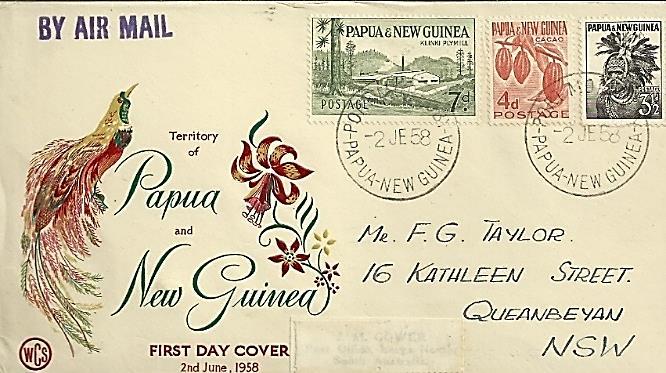
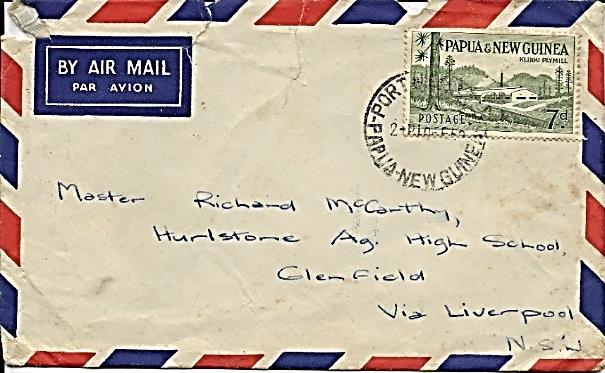
1
FORESTERS in
NEW
1922-1975
AUSTRALIAN
PAPUA
GUINEA
2 . More than one stamp sold!! 1 District Forester TPNG 1963 1975 2 CNGT stamp First day cover. Courtesy Dr Gary Bacon PNGAF MAGAZINE ISSUE # 9J W3 of 19th Nov 2022 PNG WOODS Phases of Industrial development till 1975
.,
TABLE OF CONTENTS
“FORWOOD” page 3
PNG WOODS Statistics Forest Industrial Development 1951 till 1975 page 5
EARLY MAN page 6
Need to Protect Traditional Landowners’ Rights page 8
ARRIVAL OF THE EUROPEAN page 9
Opportunists/Entrepreneurs Sandalwood and New Guinea Walnut page 10
1902 to 1928 Sacred Heart Mission Sawmilling NB page 11 1905 Alexishafen Sawmilling page 13 1908 Gilbert Burnett page 16 1911 James Mann page 19 1913 Marienberg Sawmill page 21 1920 Lack of Wood Preservation Treatments page 24
1920/21 Commonwealth New Guinea Expedition page 27
Need for correct Institutional Framework for Forest Management page 29 1921 Aropokina Sawmill CM Sawmill page 31 1920 1925 Lane Poole’s Assessment of TPNG’s Forest Resources page 33
1928 Sacred Heart Mission Sawmill Ulamona and Vunapope NB page 37 1935 Lane Poole Forest Resources of the Goldfields of New Guinea page 41 1936 An Attempt at Institutional Strengthening page 50
1939-1945 WORLD WAR 2 - Sawn Timber and Round timbers page 51
July 1943 Conference re Utilisation of the Forest Resources of TPNG page 54 Australian ArmyWW2 Sawmilling Endeavours page 56
1946 WAR EFFORT REBUILDING Sawn Timber page 74
1946 1955 TPNG Forests Yalu Sawmill page 75
1946 1961 Kerevat Sawmill New Britain page 77 1946 Numa Numa Sawmill Bougainville page 80
1947 FOREST PRODUCTS RESEARCH WORK CSIR AUST/ PNG page 81 Bill Heather TPNG Forests 1947-1955 page 82
1948 1963 Australian TPNG Forester Cadetship Scheme page 85 1948 FAO PNG page 86
1949 ECONOMIC DEVELOPMENT PNG Potential of Wood Fibre page 87
Potential of wood fibre Cutch page 87
1952 TPNG Wood Industry Status by Jim McAdam MM page 90
Potential of wood fibre Sawn Timber/Plywood Manufacture page 92
Commonwealth New Guinea Timbers Ltd (CNGT) page 93
1957 FOREST POLICY STATEMENT - HASLUCK page 98
1958 Seventh Commonwealth Forestry Tour page 98
1960’s FOOT REPORT page 104
1968 69 DEVELOPMENT PLAN PNG FOREST INDUSTRY page 107
1969 Status Forest Industry Exports page 108
Potential of wood fibre Pulp and Paper page 110
Case Study JANT Project Madang Gogol TA page 110
Case study Vanimo TA Project page 112
UNDER THEIR WATCH, WHAT WAS ACHIEVED? page 113
McAdam MM 1938 1959 page 114
Suttie 1959 1970 page 115
McIntosh/White 1970 1975 page 116
References page 1119 Acronyms page 120
2
“FORWOOD”
The question of how to make the best use of PNG’s forest resources has been and still is a complex issue. It is affected by the laws of the market, supply, demand, and competition, coupled with environmental concerns and even by history intertwined with traditional owners’ practices of subsistence agricultural systems using forest regeneration fallow methods.
Always a major issue in the implementation of development assistance efforts that adopt a sustainable livelihoods approach, is that to alleviate poverty in the first instance there is the need to provide food, shelter, and fuel. This necessitates cutting down forested land to grow crops and to obtain materials for shelter and fuel for heating.
During the period up to 1975, there was a need for PNG as an emerging nation, to develop its forest sector to assist in creating its own economy utilising its resources (including wood fibre) but at the same time ensuring peoples’ interests were protected. The Papua New Guineans owned the lands on which the forests grew. This created an enormous task, because given the pattern of traditional land ownership, the landowners had no direct or community investment in an overarching forest sector institution.
Globally, wood is grown in three structures; State; industrial forestry companies and landowners. In Papua New Guinea, all wood fibre resources were privately owned by traditional owners. The issue facing landowners worldwide is that their wood fibre prices are taken from State forest revenue systems which are nominally negotiated at less than the cost of sustained production.
Much of the work of Australian foresters prior to 1975 was to establish some format by which individual landowner groups could expect reasonable returns for their woods. The involvement of communities in forest management was a cornerstone of Australia’s forest management development in PNG.
Australian foresters had to ensure that any forest management systems developed, must have an ecological basis of rainforest management, within a sphere of multiple use of forest resources, encompassing subsistence agricultural methods.
3FAO stated that during the early development of a country, it is not financially practicable to establish a series of properly integrated forest industries or special industries that can utilize all available products of a forest. Planning must be on a practical business basis and the initial start must be made with industries that are both technically easy to establish and sufficiently profitable to amortize the capital investment. It is a question, above all, of markets, although even the initial industries should be designed with a view to their ultimately fitting into a pattern of fully integrated use of the forest as markets and finance permit
At the same time, there was an enormous need to develop wood preservation methods for PNG timbers. Throughout PNG’s history, there were no long standing timber structures. This was because the sapwood of all PNG timbers and the heartwood of some PNG timbers are liable to attack by wood destroying fungi, boring insects, and termites In addition, all
3
3 UNASYLVA Vol 8 # 3 of 1954
untreated timber placed in saltwater is liable to attack by a variety of organisms collectively known as marine borers.
The business of creating PNG forestry was to build a better PNG and at the same time ensuring PNG’s wood fibre was an increasingly strategic resource for tomorrow.
At the same time, given the enormous demand for fuelwood throughout PNG, major forest extension programs were initiated and undertaken by Australian foresters to ensure fuelwood production, especially in areas of sparse tree cover.

4
Fuel wood Acacia managium Markham Valley via Lae PNG.
Photo credit Dick McCarthy 1995.
ANNUAL LOG HARVEST4 ANNUAL EXPORT STATISTICS
Year Conifer M3
Non conifer M3
Total M3 Logs ‘000 m3
Sawn ‘000 m3
Ply ‘000 m3
1951 52 17347 29894 47241 4.6 2.5 1952 53 23065 28369 51434 2.7 2.1 1953 54 35338 40548 75886 1.9 3.3 0.96
Veneer ‘000 m3
Woodchip ‘000 Dry tonne
1954 55 61015 55891 116906 6.0 6.6 9.26 0.5 1955 56 59915 72838 132753 6.4 9.3 9.56 0.1 1956 57 52653 69712 122365 6.1 7.3 10.73 1957 58 48131 74111 122242 2.4 7.2 11.85 0.1 1958 59 43721 77553 121274 2.1 8.8 11.4 0.9 1959 60 42756 86086 128842 3.5 11.6 13.64 1.0 1960 61 45634 109353 154987 3.4 8.2 9.78 0.7 1961 62 46892 113018 159910 4.8 6.6 11.79 0.8 1962 63 39541 143466 183007 35.4 9.0 7.67 0.8 1963 64 50633 172585 223218 46.4 11.0 9.26 0.7 1964 65 51647 205568 257004 35.3 12.5 3.74 0.7 1965 66 54647 269471 324118 113.6 12.4 7.67 0.9 1966 67 65431 306449 371880 113.6 12.6 9.34 1.2 1967 68 73061 348020 421081 143.6 14.2 10.69 2.2 1968 69 71052 332452 403504 102.3 17.3 10.45 2.9 1969 70 70936 443573 514509 193.3 17.3 11.94 2.0 1970 71 75149 655767 730916 429.6 13.7 11.78 3.1 1971 72 75546 794114 869660 409.1 24.9 9.09 2.9 1972 73 48323 650196 698519 424.7 30.4 13.04 3.3 1973 74 66222 916780 983002 655.2 51.6 15.71 5.0 7.2 1974 75 74629 729193 803822 383.3 31 12.4 3.5 51.2 TOTAL 1293073 6725007 8018080 3129.3 331.4 221.75 32.7 58.4
5
PNG WOODS STATISTICS FOREST INDUSTRIAL DEVELOPMENT 1951-1975
4
75
Dept of Forests PNG Annual Report 1974
EARLY MAN
The first intervention5 into PNG’s Forest sector was early Man who was a hunter and food gatherer. Archaeological evidence indicates that humans arrived on New Guinea perhaps 60,000 years ago. They probably came from Southeast Asia during an Ice Age period when the sea was lower and distances between the islands shorter. Although the first arrivals were hunters and gatherers, early evidence shows that people managed the forest environment to provide food. There are also indications of Neolithic gardening having been practiced at Kuk while agriculture was developing in Mesopotamia and Egypt.
The Sunda and Sahul landmasses as about 50,000 to 60,000 years ago when people first came to Sahul6

The second intervention into PNG’s forested lands occurred some 5 10,000 years ago when new arrivals brought with them the knowledge of gardening and the plants to cultivate, most of which had their origin in the rainforests of Southeast Asia. They brought basic elements for a subsistence economy: plants like taro, yam, banana, and coconut as well as three domesticated animals the pig, dog, and chicken. A few native plants suited to cultivation they found in PNG as sago palm, sugar cane, certain types of bananas and breadfruit.
Establishing their subsistence economy, the people settled along coastal strips, on densely wooded islands, on jungle clad ranges and in the great rainforests of the hinterland. Living in such isolation from one another, they developed distinct customs, traditions and over 700 languages and dialects. For unknown centuries, these early inhabitants split in groups and clans and living in remote hamlets and villages, were completely lost to the rest of the World. Yet, varied as they were in tribes, clans, customs, and languages, they shared in one common invaluable friend the natural forest of the land. Despite the centuries of subsistence gardening, over 70 % of PNG’s land mass is still covered by forest. For thousands of years, these people as the sole inhabitants of PNG, found that the forests of PNG made a vital contribution to their lives and livelihood. To the hunter, the forests meant birds and animals for food and personal adornment fur, and plumage more brilliant than the rest of the world had seen. In the forest clearings people made gardens. From the forest wood, people shaped their primitive garden implements, carved their spears, bows and arrows, their clubs and other weapons for hunting and war. The forests gave them fuel, bark, and fibre for clothing. It provided timber for shelter and thatching for roofs. The forests gave them their
PNGAF Mag #1 of 1st oct 2020
6
5
6
Bourke RM and Harwood T Food and Agriculture in Papua New Guinea. ANU Press 2009
sole means of transport i.e., the canoe log. The people whose technologies included bone, wood, and stone tools, had a productive agricultural system.
From the smallest yam storage house to the great Haus Tambaran 30 metre long and 15 metres high, their skills were practical and often highly developed.
Belam cult house (Haus Tambaran) of the Maprik Region7 .
Haus Tambaran or spirit house.8 .

Coastal dwellers looked to the forests for materials to fashion their canoes, fishing nets and traps, for the fibre to bind their great multiple log sea craft and even caulking for their craft came from the fruit of a jungle tree. In the whole of the land, the canoe log was the basis of their sole means of transport, for these people used neither wheel nor beast of burden.
They traded along the coast (mainly in pottery, shell ornaments and foodstuffs) and in the interior (exchanging forest products for shells and other sea products.)
Photo taken in 1887 of large Lakatoi used for trade between Port Moresby and the Gulf of Papua


7
8
7
Photo credit Crawford House Press ISBN 1863330364.
Photo credit J K McCarthy Patrol into Yesterday 1963.
NEED TO PROTECT TRADITIONAL LANDOWNERS’ RIGHTS
Early people realised the importance of forests for their source of their livlihoods and they have acted both to protect them and to promote the growth of useful trees. PNG Forests have been managed sustainably for thousands of years.
The aim of development has always been to reduce poverty. In its earliest forms, the emphasis was on overall economic growth. Later there was increasing focus on distributional impacts and improving the welfare of the poorer. More recently, focus on meeting basic needs, then on food security and later livelihood enhancement. The evolution of forestry development has reflected these changes 9
The Forests of Papua New Guinea are not owned by the government but by the clans and tribes, as in most of the countries of the Pacific.
In 1974 a mere 89 000 ha were State owned and even this was contested by the people.
The government must negotiate with the clans and tribes for the use of the forest resources. Many of the traditional ownership groups however are very reluctant to sell forest land even if it is not required by them for development. They usually are only prepared to sell the timber rights for a specific period up to 25 years.
At the end of 1976, under the Forest Act 1936, government had purchased the timber rights of 2 226 000 ha. Often this purchase is quite complex.
For example, over an area of 63 000 ha in the Gogol and Ramu valley near Madang there are as many as 250 district land owning groups with 8 different languages among a population of only 2 300 people. With all owner groups an agreement must be reached before industrial development can start.
In the Land Groups Act of 1974 there is a provision to recognize clans as cooperatives and the “Land Dispute Settlement Act” provides for disputes over land, boundaries etc.
Under the Forestry Act of 1971 timber owners can directly deal with the logging company after the minister in charge of forestry matters declares the area as a “Local Forest Area”. Under Forest Act 1937 landowners may sell small quantities of timber up to approximately 50 m3. Some cutting is allowed on freehold property.
8
9
Vol 8 # 3 of 1954
Unasylva FAO 1981
ARRIVAL OF THE EUROPEAN
The third intervention came in the 19th century with the arrival of the European brought far reaching and permanent change and a slow but inevitable mutual awakening of PNG to the rest of the World.
Initially the newcomers had little impact on PNG’s forested land or the role the forests played in the customary life of the people.
188510 . An expedition preparing to set out from Port Moresby in 1885 for the crest of the Owen Stanley Ranges.


Source. Commonwealth Dept. of Territories. 1959.
1897. Burns Philp wharf Port Moresby with railway.
Source PNG National Archives.
9
10
Reference PNGAF Mag #2 of 7/10/20
OPPORTUNISTS / ENTREPENEURS- Cedar, Sandalwood and New
Guinea Walnut
Australia administered Papua from 1901 and declared it a Commonwealth Territory in 1906.11 It took over German New Guinea during the First World War and was mandated to administer it by the League of Nations in 1920. The Territories attracted little interest in Australia in the 1920s, their combined European population was slightly under 2000, their exports were unimportant to Australia, their commercial history was poor, and they required grants to administer. Nevertheless, they attracted men, like Judge Hubert Murray (1861 1940) and Staniforth Smith (1869 1934) who were remarkably dedicated to good government. The only scientist they employed was the Government Geologist, Evan Stanley (1885 1924). However, their botany had long attracted collectors, particularly of the orchids. A formidable British Lieutenant Governor, Sir William MacGregor (1846 1919), had even sent specimens gathered on his ascent of Mount Victoria to Ferdinand von Mueller, the Government Botanist in Victoria, in 1889.
When Murray was appointed Administrator of Papua in 1907, cedar logs were being exported, but there was only a little practical knowledge of the other species.
McAdam12 reported that with the arrival of the white man, it was found there was a scattering of valuable trees which were attractive to buyers elsewhere. Some attempts were made to float out easily accessible logs of species such as cedar.
In the period from European contact and settlement in the late nineteenth century, to the outbreak of World War 2 in the Pacific, the timber industry was concerned mainly with speculative exploitation of cedar, sandalwood from around Port Moresby, and New Guinea walnut from New Britain and New Ireland13. The utilisation of the forests was mostly incidental to other activities like gold mining or agricultural plantation development.
The wharf at Samarai in 1927. Source. Samarai Views 1927. Collection John Oxley Library Brisbane. Lewis14 provided a detailed analysis of land settlement by Europeans and the early vicissitudes of plantation agriculture in British New Guinea and Papua up until the outbreak of war in the Pacific in 1942.
B McAdam’ address to Papua and New Guinea Scientific Society’s annual report of 1952 “Forestry in New Guinea”
New Horizons 1973 Jacaranda Press. 14 Lewis DC The PLANTATION DREAM Developing British New Guinea and Papua 1884 1942

10
11 PNGAF MAGAZINE ISSUE #
12
9A of 15th March 2021
J
13
1902 to 1928.
SACRED HEART MISSION NEW BRITAIN15 Toriu River to Kurindal NB
16
The first Catholic missionaries from the French Most Sacred Heart of Jesus order, arrived at Matupit Island in Simpsonhafen in September 1882 and established a mission station at Vunapope near Herbertshoehe (Kokopo) in 1889.
They actively sought commercial ventures establishing plantations, sawmilling, and investigated starting a brewery. They dominated the sawmilling industry in the Islands region for the next seventy years.
Saw milling operations by the Sacred Heart Mission began on the Gazelle Peninsular in 1902 at Toriu River and then in 1917 moved to Kurindal and finally to Ulamona in 1928.
Source Mandated Territory of New Guinea Annual Report 1921 1922 p 69 70.

Their Toriu River Sawmill with a 700 mm gauge timber logging railway timber sawn was operational by 1902. It supplied sawn timber for their base at Vunapope near Kokopo.

Sacred Heart Catholic Mission (Vunapope) sawmill at Toriu River 1906 to 1913.
Source Michael Pearson.
15
End of the Line A History of Railways in Papua New Guinea Bob McKillop & Michael Pearson UPNG Press 1997.
16 Reference PNGAF Mag #2 of 7/10/21 p2.
11
Mission labourers hauling a record Eucalyptus deglupta log on the Toriu River logging railway around 1910 with German missionaries supervising. Source PNG National Library photo 314 Historishes Bildmaterial our dem Archives des staatlichen Museums fur Volkerkunda Dresden. Source. Der Transport zum Sagewerk; Das grobe Gatter; Arbeiter im Sagewerk; Das Sagewerk am Toriu.



View of the Toriu River Sawmill around 1902 1917. Source Michael Pearson PNG National Library photo 313. Source: Pioniere der Sudsee Werden und Wachsen der Herz = Jesu Mission von Rabaul zum Goldenen Jubilaum 18821932. p117, 118, 132 & 177.
In 1917 the mill moved to Kurindal a few miles north. There was a small saw milling area of Nambung Saw Milling Company owned by Bolten Bros near Massava. Source: Mandated Territory of New Guinea Annual Report 1923 1924 p 80 In 1928, the application for a timber lease by the Catholic Mission of Most Sacred Heart of Jesus for 2010 hectares at Ulamona was successful. They closed their mill at Kurindal and established a new mill at Ulamona.
12
German New Guinea’s most ambitious industrial enterprise was established in 1905 by the SVD Mission at Alexishafen on Sek Harbour. A large steam powered sawmill was in operation by the end of 1905. At first the logs were cut within the immediate area of the mill, but it was soon necessary for a 700 mm gauge railway to be constructed some 4 km into the forest to haul logs to the mill. There were several substantial bridges including a roofed bridge spanning the Bigges River.


Donkey tram pulling logs over cover bridge. at Bigges River.
Source SME Wagner ELC PNG Butaweng SM.
13 1905 ALEXISHAFEN SAWMILLING17
17 End of the Line A History of Railways in Papua New Guinea Bob McKillop & Michael Pearson UPNG Press
1997

14
A section of the botanical gardens in Rabaul established during the German administration around 1905. (M. von Hein Collection). Later volcanic eruptions destroyed the gardens.


15
1908


18 GILBERT BURNETT.
The Australian administrator of Papua and New Guinea Murray, first attempted to survey the timber potential of parts of Papua in 1908. By arrangement with the Queensland Government, a Queensland Forest Inspector Mr Gilbert Burnett went to Papua to report on its timber resources. He stayed there for seven months and visited various places along the coast from the Purari Delta to Samarai and in the vicinity of Buna Bay to the north east. Mr Burnet19 reported he had some difficulty in penetrating into the country, but he produced a report of an optimistic nature, and he listed 120 species of trees by their Papuan names, obtained wood samples and classified them according to use, but not botanically.
20The death is announced of Mr. Gilbert Burnett a highly respected resident of Wellington Point.
The late Mr. Burnett was one of the early seekers on the Gympie field when it broke out. In going over the ranges at Conondale they let the dray down by way of a rope made fast to trees.
Later, Mr. Burnett settled at Burpengary, and after a few years he took charge of his father in law's sugar plantation and mill at Woondall, near Wynnum.
From there he took control of the late Captain Hope's sugar mill at Ormiston, and later he bought the mill and a large tract of land at Wellington Point, where he erected the mill and grew sugar cane.
Subsequently he converted the mill into a sawmill and carried on timber milling for many years.
18 Reference PNGAF Mag # 9B 5 of 21/4/21 p7.
19 1908 Gilbert Burnett Timber Trees of the Territory of Papua Reports and catalogue Public Library of Victoria 31 Aug 1911


20
Transcribed from “the Queenslander Saturday 23rd May 1925.
16
But misfortune came, the whole mill and contents being burnt down. Mr. Burnett held a position in the Queensland Forestry Department and made many friends' during his travels in all parts of Queensland and New Guinea



17
Page 51 of the Annual Report Gulf Division 1/7/1908, the Resident Magistrate Kerema, reports on lands and timbers including the illegal cutting of cedar and Gilbert Burnett’s visit.
Very little land is situated near the Coast. What there is now is fully occupied by the natives with their gardens. Beyond that and behind that extends a sago belt the whole length of the coastline.

During the year, a trip was made up the Vailala River with Mr Burnett, who had come over from Queensland for this government specifically to look into the timbers.

It is much to be regretted that in the past many thousands of feet of valuable cedar had been cut and allowed to float out to sea. The result is that the Vailala River has now no cedar of any extent within a considerable distance of its mouth.
I fancy the main difficulty will be in transporting the logs from where they are cut to the river and a light line of rails laid on sleepers made of the saplings with which the scrubs are full, might be of value.
From what one hears from the natives, it would appear that the heavier timber will be found on the Purari River. There is a considerable quantity of cedar up this river, and as it has never been touched, is likely to be more easily got at.
I have cut cedar trees close to Kerema, growing almost in the company of mangroves and with total streams quite close to them.
18 21
21 Page 1 nia.obj 15829293502
National Library of Australia
1911 JAMES MANN22

In 1911, James Mann23 (1857 1921), presented a paper of his work on six Papuan timber species titled 24Papuan timbers some of the properties of six specimens, by James Mann, 1911. 22 Reference PNGAF Mag # 9A of 15/3/21 p20.

19
James Mann was a leading researcher and authority on determining the strength and durability of Australasian timbers, and pioneered methods for identifying species using microscopic examination, and splinter tests. Mann was Government research scholar at the School of Engineering, University of Melbourne, 1910 1912, and oversaw the Engineering Laboratory, for 20 years when Professor W. C. Kernot occupied the chair of engineering.
James Mann wrote several papers in conjunction with the Victorian Institute of Engineers, the Royal Society of Victoria, and other technical bodies, and was consulted by the Victorian Forests Department after it was formed in 1908.
He published a textbook Australian Timber: its strength, durability, and identification, 1900. An extended second edition was published in 1921, that included more detailed research based on test samples with known age, forest location, and soil conditions, as well as including details about imported timber species from Papua, Burma, New Guinea, and New Zealand.
Source

20
23 Entry in Encyclopedia of Australian Science 24 https://www.biodiversitylibrary.org/itemdetails/33805 Vol 24 of 1912 pages 20 45
Flagstaff Hill Maritime Museum and Village Author James Mann Publisher Walker may & Co 1900.
1913 MARIENBERG SAWMILL AND RAILWAY25
SVD
Another SVD photo, caption German. M Pearson.

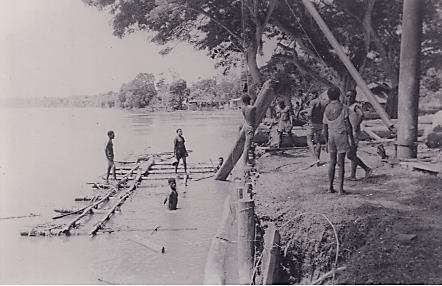
21
missionaries established a station at Marienberg on the lower Sepik River in 1913.
Lifting a log from a raft on the Sepik River. Source Fryer Collection.
25 End of the Line A History of Railways in Papua New Guinea Bob McKillop & Michael Pearson UPNG Press 1997
Log on rail truck. Source Office of Information and Extension Services, National Library and Archives at Waigani.
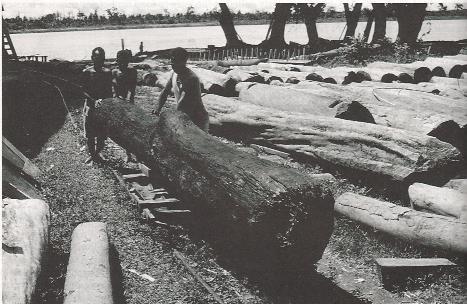
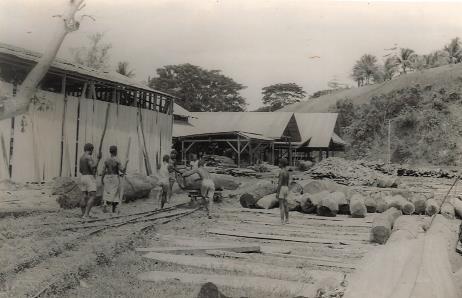
22
Log yard. Source National Archives Waigani.
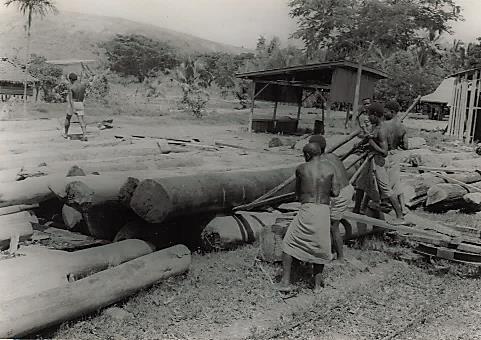
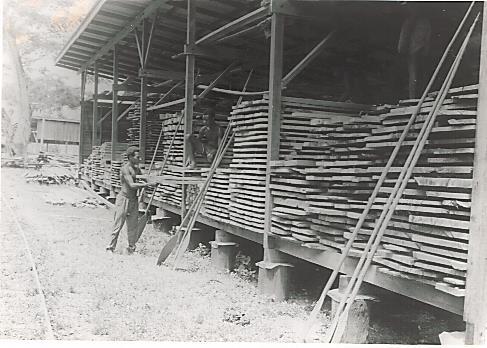
23
Log yard. Source National Archives Waigani.
Drying sheds. Log yard. Source National Archives Waigani.
1920. Lack of Wood Preservation Treatments26
Throughout PNG’s history, there were no long standing timber structures. This was because the sapwood of all PNG timbers and the heartwood of some PNG timbers are liable to attack by wood destroying fungi, boring insects, and termites. In addition, all untreated timber placed in saltwater is liable to attack by a variety of organisms collectively known as marine borers. There was an enormous need to develop wood preservation methods for PNG timbers.
Back in 1920, the problems of a lack of timber preservation treatment were highlighted in the 1918 19 PAPUA Annual Report. 27 Extract. The staff consisted of the Acting Director, Superintendent, Road Engineer, Draughtsman, Acting Accountant, and a temporary Clerk for part of the year, together with a storeman and two or three overseers for varying periods. The Superintendent Mr. J. MacDonald returned from vacation leave on the 21st of October 1918. Mr. G. M. Turnbull draughtsman, acted in Mr. MacDonald’s place during the latter's absence, and Mr. Turnbull went on six months' leave on the 23rd of August 1918, returning on 4th March 1919.

With regard to the office staff, I have had to be content with an acting accountant, who had no assistance during the greater part of the year, the result being that much of the work got seriously behind and any attempt at keeping correct records and costs of work had to be almost abandoned. I also had to manage with a shortage in the mechanical staff, both these difficulties being due to the reluctance of the Government to fill positions which might at any day be made available to officers returning from the Front. When all the returned men who can reasonably claim positions have been absorbed, it will still remain necessary to find more men for the mechanical staff, as a large amount of maintenance work, which in normal times would be regarded as absolutely essential, has been permitted to stand over, partly owing to the shortage of men, but mainly due to the high cost of materials and the scarcity of shipping.
However, the new position will have to be faced, as the general opinion throughout the world appears to be that the tendency during the next few years will be for the cost of both material and labour to increase. For the reasons already stated, the majority of our buildings are falling into a dangerous state of disrepair, so much so that if they are not attended to very soon, they will not be worth repairing. These remarks apply to the buildings at Moresby and Samarai, but much more so to those on outstations, where, in addition to the shortage of labour and the high cost of materials, I have had to contend with the very serious shortage of

26
REF: PNGAF Mag # 9A of 15/3/71 p22
27 Extract of W R Smith’s Acting Director of Public Works, Public Works Department. Annual Report for the year ended 30th June 1919 (pages 67 to 70
24
local shipping, with the result that an inspecting officer would be occupied for months in going the rounds of all the stations to ascertain what is required.
Owing to the very high cost of Australian timbers, and the increased freights charged by the small amount of shipping available, I have endeavoured to get along with timbers supplied by the local sawmills, but the results are very far from satisfactory. The timbers being cut from immature logs and badly milled as well, the result being that a perfectly straight stick is quite an exception, thus involving considerably more labour in the construction of a building than would be necessary when using properly milled timber. I am, therefore, going into the question as to whether it would not pay better to obtain Australian timbers, even at the enhanced prices prevailing. This all leads to the question as to whether it is any longer the best policy to erect wooden buildings, which are all open to the dangers of being attacked by white ants, woodborers, dry rot, and all the other disabilities to which timber is subject in the tropics. I am seriously considering the question of erecting all future permanent buildings with concrete walls.
At the present time, Government offices are scattered all over the town. They are all timber structures, some of them having been erected more than twenty years ago and are now quite inadequate in size to provide for the increasing staff. A proposal to construct one building to contain the whole of the Administrative staff has been discussed, and should this idea be carried out, it would become a great convenience to both the public and the Government staff. At present, much time is lost in getting from one Department to another.
New Wharf As mentioned in my previous annual report, work was suspended in November 1917, pending arrangements being made to obtain expert advice from Australia as to whether the work was being carried out on the best lines. A report was obtained from Mr. Mann on the preservation of timbers in tropical sea waters, and Mr. Hall, of Brisbane, also visited Port Moresby, and made an inspection and report. Subsequently it was arranged that before proceeding further with the work, the advice of Mr. T. Hill, of the Commonwealth Works and Railways Department, should be obtained, but Mr. Hill was apparently never able to visit the Territory, and therefore nothing has been done with the exception of fixing some bollards and fenders. Arrangements are in hand for the erection of a cargo shed, 140 feet by 30 feet, on the shore end of the wharf, and this work will be put in hand immediately, thus very much relieving the congestion which has recently existed.
Complaints have been received for a long time from residents at Samarai regarding the inadequacy of wharf and shed accommodation at that port, and as the existing wharf is getting into a state which is almost beyond repair, the question is under consideration as .to whether funds should be made available to grant the facilities demanded.
The question of better hospital accommodation for natives, both at Samarai and Port Moresby, has been much discussed, and preliminary schemes have been worked out, but the matter is now .in abeyance pending the return of Dr. Buchanan, C.M.O. and Dr. Giblin, G.M.O., Samarai, from active service.
25
About 3 acres of land have been reclaimed from low lying ground at Samarai, ·and arrangements are now in hand to segregate the gaol accommodation, police barracks and native hospitals on this area. The main gaol, head gaoler's cottage, warders' quarters, kitchen, and latrines have already been erected. With regard to the road from Port Moresby to Sapphire Creek, a large copper mine is in course of development at the end of this, and the company is using heavy traction engines, weighing up to 13 tons, for the transport of their ore to Port Moresby. As it was recognised, both by the Government and the company, that this could only be regarded as extraordinary traffic, an arrangement was come to under which the company undertook to maintain the road during those months of the dry season when they are using it. The company has put in several deviations to reduce curvature and grades, which was done entirely for their own convenience, but is certainly an advantage to the public. I regard the result of the arrangement as entirely satisfactory from both the Government and the public point of view. Arrangements were made to construct a road from the coast at Kapa Kapa to the Kemp Welch River, a distance of about 17 miles, to serve some plantations there. About half of this length has been constructed sufficiently well to carry wheeled traffic in the dry season, but a large expenditure in metalling, bridges and culverts will be necessary, to make the road fit to carry wheeled traffic throughout the year. I do not consider that the traffic at present in sight justifies this expenditure.
On the high country in the Sogeri District there is some excellent rubber land, where several thousand acres are in bearing, and difficulties of transport are generally recognised as a serious handicap. The Government has recognised for a long time that these difficulties should be remedied, but the mountainous nature of country offers many obstacles to road construction. I have always advised that thorough survey should be made to ensure the best location before any money is expended on construction. This, of course, takes time, but the surveys have now been completed, and I am convinced that the route now pegged is in the correct place though it is not all easy going. A start is to be made immediately on the construction of a good mule track along this route, which can eventually be improved to carry vehicular traffic. Even this, although only a mule track, will be a great boon to the planters, as the existing track contains many almost impossible grades. The water supply of Port Moresby is provided by a corrugated iron catchment, about two thirds of an acre in extent and a reservoir capable of holding 500,000 gallons of water. The water is distributed through the town by a 4 inch 'main, with standpipes 300 or 400 feet apart. The Department delivers water into tanks at the various tenements at a charge of l0s. per 1,000 gallons. With this very limited supply we could not dare to reticulate each household, as we would very soon find ourselves without water even with all the care exercised, we are sometimes on the verge of finding the reservoir entirely exhausted, and it is probable that eventually some better arrangement will have to be made. At a distance of about 20 miles from Port Moresby we have the Rouna Falls, on the Laloki River, at an elevation of some 1 400 feet above sea level, with a flow which would be sufficient to provide a water supply for a city with a of many thousands. It is my intention to go into this question in the near future and submit a proposition and estimate of cost.
26
1920/21 Commonwealth New Guinea Expedition.28 In 1918 the Department of Home and Territories tried unsuccessfully to engage an experienced tropical forester from the Philippines or to borrow one from India with the wider brief to inspect the timber resources … and report … the best means of conserving and developing these resources. In 1920/21 the Commonwealth Government commissioned the Commonwealth New Guinea Expedition who presented an interim report titled Reporting on the Natural Resources of the Mandated Territory. May 1922.



27
28
Ref: PNGAF Mag # 9B-5 of 21/4/21 p 8. Ref PNGAF Mag # 9A of 15/3/21 p 37
Page 8 Interim Report Commonwealth New Guinea Expedition 9/12/20-14/11/21. During the military occupation of the Territory, no organised effort was made to ascertain its actual and potential resources. Casual reports occasionally came through from the Administrator to the minister of defence and were based for the most part on observations by police masters, deputy district officers etc. or sometimes through the Rabaul Lands department. Just before the introduction of the New Guinea Bill, the Prime Minister decided that an expedition suitably equipped for the purpose be sent to New Guinea. The writer had a conference with him, and the Minister of Defence and the Expedition was outlined in several official memorandum submitted to and approved by Mr Hughes.
General instructions were that the expedition should not cost more than 10,000 pounds and should not be absent for more than a year, be under the sole control of the Prime Minister’s department and a roving commission within the Territory.
The main purpose of the Expedition was to conduct investigations regarding natural resources along every possible avenue which would yield reliable information helpful to the Federal Government. The Territory had a land area of 72,000 square miles and it was not part of the objects of the expedition to attempt to explore such an area. The main object in making a voyage was to gain information at first hand relating to general questions such as land, manpower, trading, recruiting, waterways and power, anchorages etc. and to visit the more remote and little known parts away from the shipping routes and in uncharted waters. During its currency, provision was made for conducting the customary observations of a scientific expedition such as meteorological work, mapping rivers, reefs, mountains, measuring potential power of waterfalls, determining latitudes and longitudes, measuring altitudes, taking soundings, recording natural phenomena such as earthquakes, geysers etc.
A boat was purposefully built called The Wattle.

Commonwealth New Guinea Expedition 9/12/20-14/11/21. Photo credit National Library Canberra.

28
NEED FOR CORRECT INSTITUTIONAL FRAMEWORK FOR FOREST MANAGEMENT
Early attempts to institute forest management legal frameworks are highlighted in the Papua Annual Report of 1908.



Timber Ordinance of 1907 Annual Report Papua 1908 page 5. Annual Report Papua 1908 Page 6.
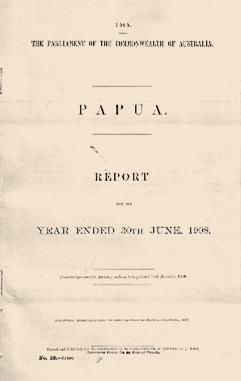
29
Annual Report Papua 1908 Page 8 Timber Licences.
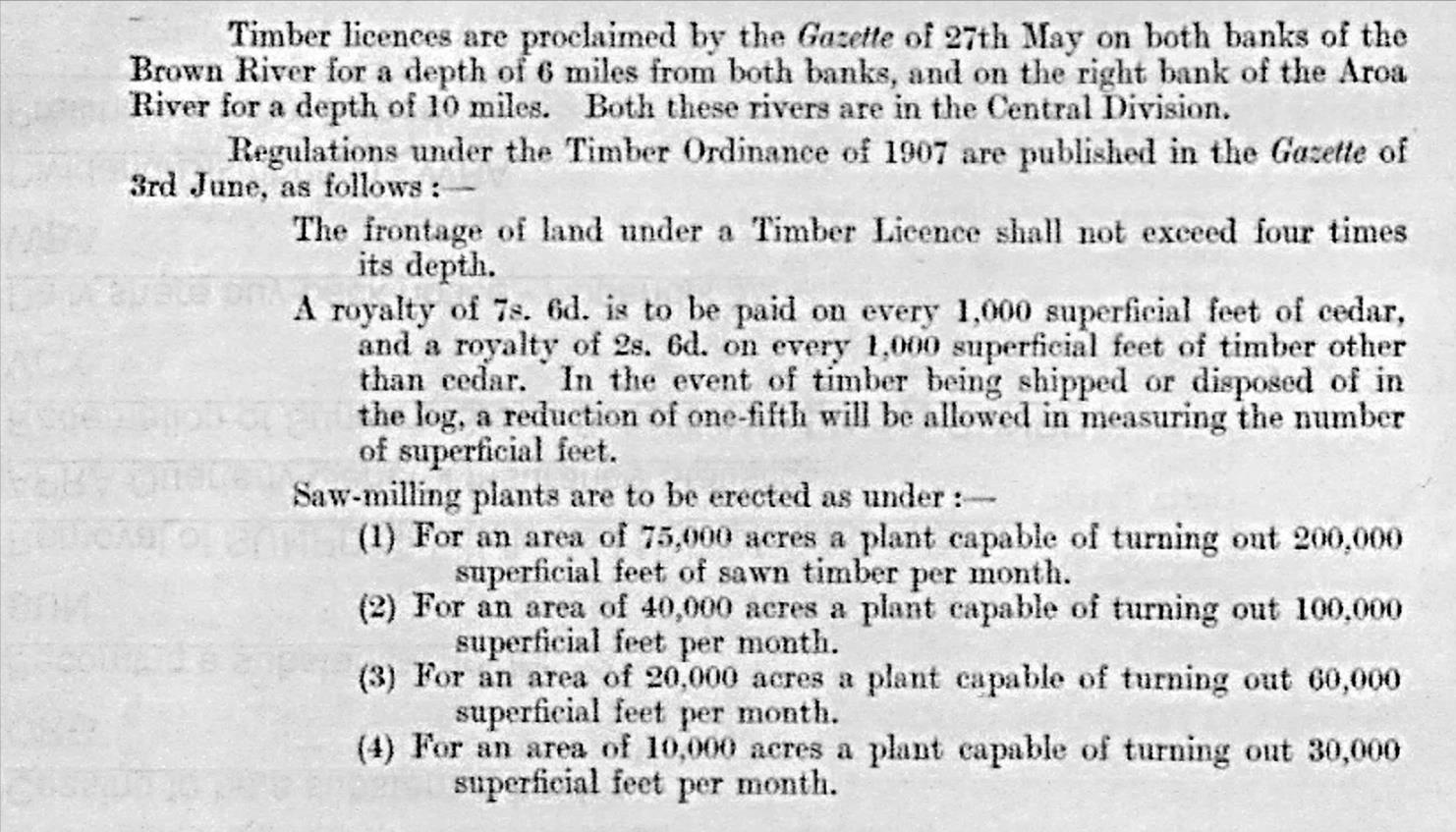
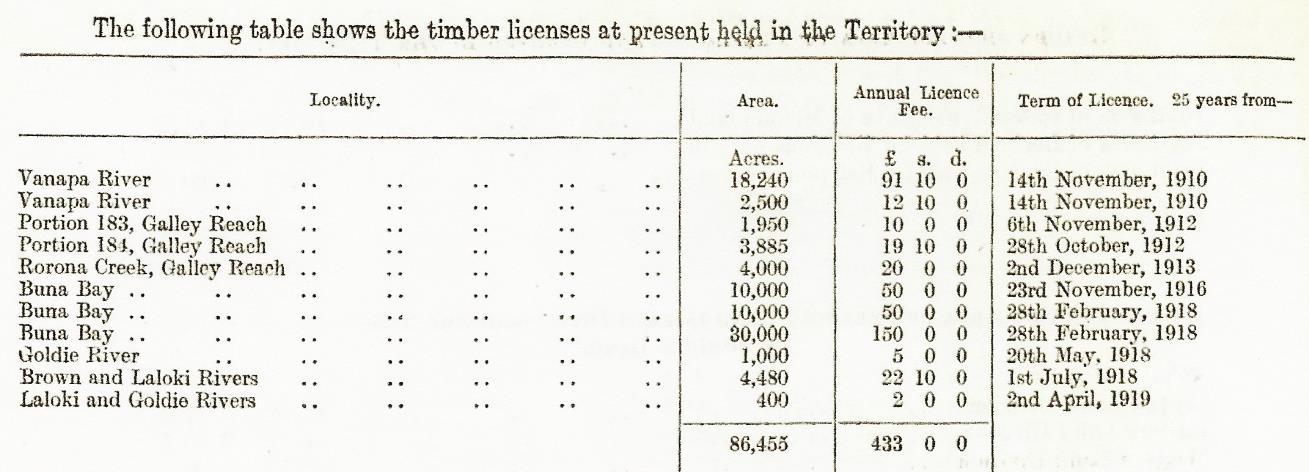
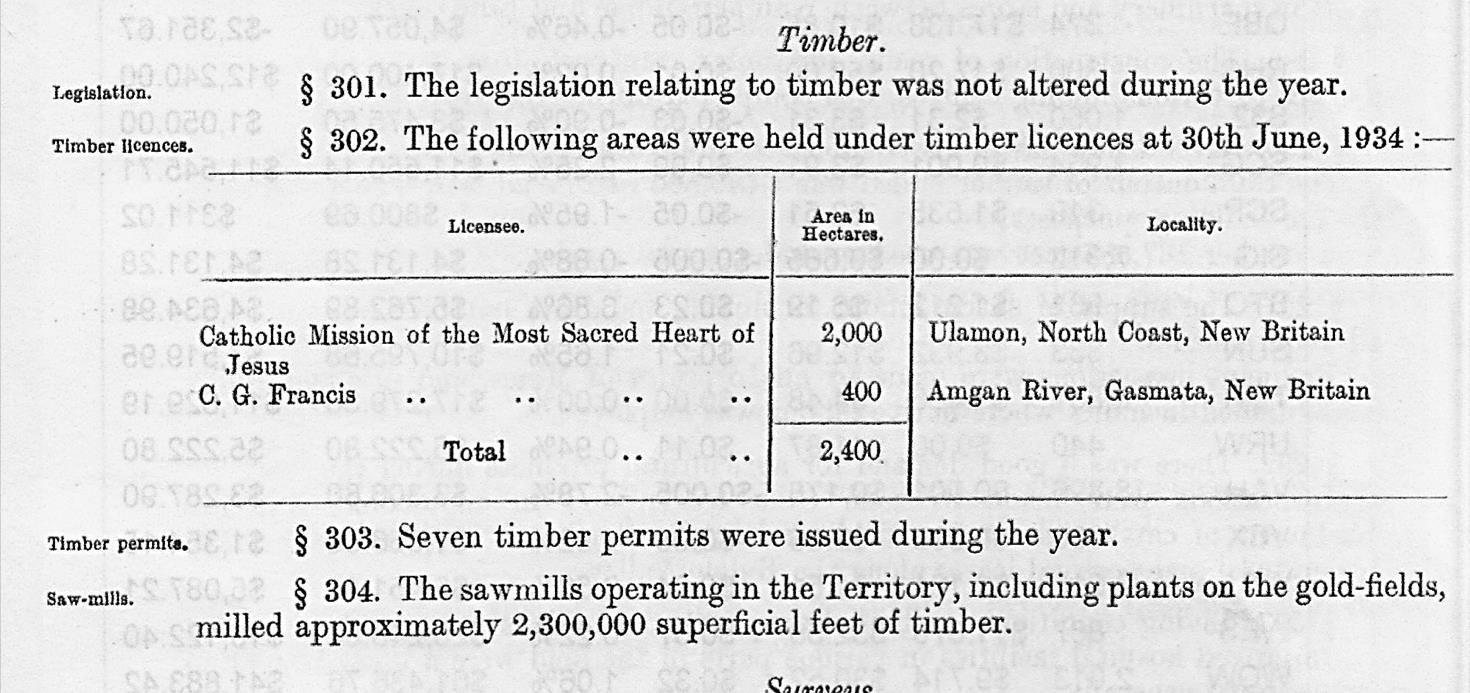
Timber Licenses 1918 1919 Papua Page 72.
Annual Report to the UN re the Administration of New Guinea 1/7/1933 to 30/6/1934 p 96.
30


31
1921 Aropokina Sawmill CM Sawmill
Photo credit National Library of Australia. Photographer Frank Hurley.
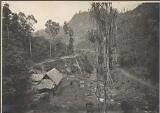
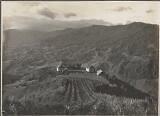
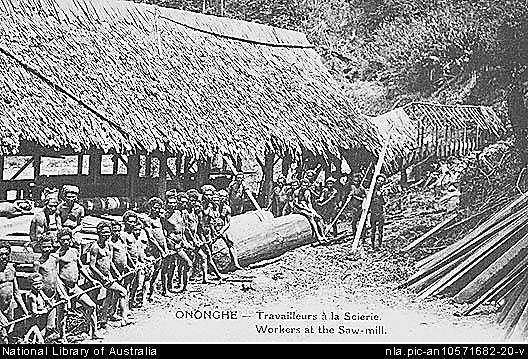
32
Source National Library of Australia.
1920 -1925 LANE POOLE’S ASSESSMENT OF TPNG’S FOREST RESOURCES
29
Requests for Lane Poole’s Surveys
Parts of the Australian timber industry became worried about their supplies when New Zealand had banned exports of its white pine (Podocarpus dacrydioides) and kauri (Agathis australis) that were used for butter boxes, while at the same time supplies of Australian kauri (Agathis robusta) and hoop pine (Araucaria cunninghamii) were diminishing. In 1920 a Melbourne timber agent, Victor Trapp, arranged for one of the timber companies to investigate the possibilities of obtaining case, match and plywood material from Papua. Nothing came of the industry investigation, but when Trapp learnt of Lane Poole’s resignation from Western Australia, he suggested that the Commonwealth should secure his services.14 With no other job in sight, Lane Poole accepted a 12 month appointment that was later extended by 6 months. For New Guinea, W. M. Hughes, in one of his more erratic actions as Prime Minister, supported an ineffective private scientific expedition at about the same time. This took with it a forest inspector from Queensland, F. W. Hayes, who fell ill, and it was left to the geologist, Evan Stanley, to write the report, including a few notes on timber. The new administration knew little else about New Guinea’s forests, but when it heard that two companies were being formed to exploit their timber, it asked Lane Poole to continue his Papuan survey for a further year in New Guinea.
1921/1922 Lane Poole Arrives
Forestry page 81 of Annual Report Papua 1921-22. Very little had been done during the year in commercially exploiting the timber resources of the Territory. A great proportion of the timber licenses have been cancelled during the period under review. The only licences at present in existence are five held by the New Guinea Copper Mines aggregating 17,340 acres (one on Woodlark Island of 12,000 acres, and one on the mainland near Samarai of 2,600 acres.
Mr C E Lane Poole, a forester of long experience in various parts of Africa and in Western Australia and possessing very high credentials was engaged for twelve months from 16th March 1922 to report generally upon the timber resources of the Territory. Mr Lane Poole arrived on 9th April 1922 and up to present has only been able to inspect the country around Galley reach in the Central Division. No detailed report has as yet been received but generally speaking, his views regarding the timber resources of that locality are not very favourable
29 From exploitation to science: Lane Poole’s forest surveys of Papua and New Guinea, 1922 1924. Historical Records of Australian Science 17: 71 90. by John Dargavel School of Resources, Environment and Society, Australian National University, Canberra, ACT 2000, Australia. Email: john.dargavel@anu.edu.au

33
Forestry page 37 (Report to the League of Nations on New Guinea 1923 to 1924). The investigation and classification of the timber resources of the Territory were commenced during the year, the work being entrusted to Mr C E Lane Poole a forestry expert, who had just previously completed a similar task in the neighbouring Territory of Papua
In 1924 the Commonwealth Government took a positive step towards involvement in forestry by the appointment of Lane Poole as its Forestry adviser.
Charles Lane Poole at Madang, 1924, showing the remains of a radio damaged in the raid at Kohu. Note his gaunt appearance after the rigours of his expedition to Mt Otto. Source: C. E. Lane Poole, Forest Resources (1925), courtesy of the National Archives of Australia

In 1925, Lane Poole presented his Report Forest Resources of the Territories of Papua and New Guinea, to Federal Parliament
30Don McIntosh recalls during the 1950’s another activity was the reconnaissance assessment of the coastal forest of Open Bay which had been logged for walnut some 20 years previously. The survey, to assess the log export potential of the forest, was done under the watchful eye of Lane Poole. Lane Poole first came to Papua New Guinea in 1922 and produced, after a lot of field work, the first document on the forest resources of Papua New Guinea. He was a small tough old chap with a hook arm who must have been in his late 60’s when he went on the Open Bay survey.
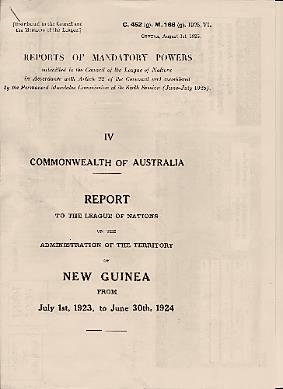
34 1923/24
30 Reference PNGAF Mag # 9B 5B4M2 of 27th July 2021 Eminent TPNG forester Don McIntosh.
1923-1925. Lane Poole Forest resources Report 31 32 In 1925, Lane Poole presented his Report Forest Resources of the Territories of Papua and New Guinea to Federal Parliament. In 1923 and 1924, Charles Lane Poole completed a survey of Papua and New Guinea and recommended the establishment of a forest service. . 31 Ref: PNGAF Mag # 9B 5 of 21/4/21 p 9. Ref PNGAF Mag # 9A of 15/3/21 p37 32 Cover page C E Lane Poole 1925 Report on Forest Resources of the Territories of Papua and New Guinea Government Printer Melbourne 209 pp


35
In Dargavel’s review of Lane Poole’s survey 33 a major problem for Lane Poole was to determine the species of each tree, given that there were 50 60 different species at each site and about 400 overall. However, people with an intimate knowledge of the trees of a particular area can name them from the look of their leaves, bark, trunks, crowns, and many small details. Lane Poole found that ‘The bush native has a wonderful knowledge of his trees.’ He used their skill in identifying each species to record them consistently across each site. For each new species he encountered, he collected specimens of the bark, wood, and leaves, as well as the flowers or fruit when they were present, sometimes trying to shoot material down from the crowns but more commonly having someone climb up. He used a pre printed sheet of headings to record each species by its herbarium number and local name and to give a detailed description of the living tree.
Lane Poole devised a metal drying box that he used to dry his specimens instead of pressing them between paper in the conventional way. Even when dried initially and kept pressed in paper, he passed them through the drier periodically to ensure that they were kept free of mould until they could be despatched to the Queensland Herbarium for identification.
The specimens sent to the Queensland Herbarium for identification arrived in good condition, thanks to Lane Poole’s attention to drying them carefully. They were examined by C. T. White and W. D. Francis. White and Francis provided Lane Poole with as many names as they could for his 1925 report. They noted that the collection showed that the flora of the Territories was closer to that of Southeast Asia than to Australia’s.
Lane Poole collected wood samples that he examined himself using a set of hand lenses. He recorded a general description of each, the width of the sapwood, the colours of sap and heartwood, and measurements of the frequency of the rays and pores. He also remarked on how the wood cuts in general categories of ‘cuts hard,’ ‘cuts firm,’ ‘soft to cut,’ ‘splits easily’, and so on. Lane Poole also collected and described samples of the bark. His report includes measurements of the basic density of the wood samples and of the colour and presence of precipitates in solutions extracted from many but not all the wood and bark samples. He does not report whether he made the density measurements and extractions himself. (Presumably, this work was done by James Mann).
In 1927, Lane Poole became the Commonwealth Inspector General of Forests and Acting Principal of the Australian Forestry School (1927 44) in Canberra. He was also the Administrator of the Forestry Bureau which he had proposed to co ordinate education, research, and policy (not formally established until 1930). The research section which he first promoted in Western Australia to include research into making paper from eucalypts was developed in Melbourne as the Division of Forest Products of the Council for Scientific and Industrial Research. The forestry research section of the bureau eventually developed as the Division of Forest Research, C.S.I.R O in Canberra
33 From exploitation to science: Lane Poole’s forest surveys of Papua and New Guinea, 1922 1924. Historical Records of Australian Science 17: 71 90. by John Dargavel School of Resources, Environment and Society, Australian National University, Canberra, ACT 2000, Australia. Email: john.dargavel@anu.edu.au
36
1928 to Present SACRED HEART MISSION Sawmill NEW BRITAIN34
In 1928, the application for a timber lease by the Catholic Mission of Most Sacred Heart of Jesus for 2010 hectares at Ulamona was successful. They closed their mill at Kuriendal and established a new mill at Ulamona35 .
Ulamona Sawmill Jetty Sacred Heart Mission.

Source Michael Pearson.
34 End of the Line A History of Railways in Papua New Guinea Bob McKillop & Michael Pearson UPNG Press 1997.
35 Source: Mandated Territory of New Guinea Annual Report 1928 1929 p 94 pg. 280. Source: Pioniere der Sudsee Werden und Wachsen der Herz = Jesu Mission von Rabaul zum Goldenen Jubilaum 1882 1932. p117, 118, 132 & 177.Yumi Pipel Bilong God Histori bilong lotu katolik long Arsdaiasis bilong Rabaul 1982.

37
Ulamona sawmill. Source Ulamona Sawmill OIES Office of Information and Extension Services. Taken 1960s.
Sawn timber at Ulamona Mission sawmill in the shadow of Mount Ulawan (“The Father”) an active volcano.
Source Michael Pearson 1960.
Ulamona sawmill with large solid Kamarere log.
Source John Davidson 1978.
Timber stacks and railway yard Ulamona Sawmill, c.1960 .PNG National Archives



Source Michael Pearson.
At Ulamona, a 700 mm gauge logging railway was constructed from the sawmill inland for approximately 10 kilometres. A line of
38
lighter construction was laid over 100 metres from the mill down to the jetty to carry the sawn timber for loading onto ships. A steam locomotive was imported in 1928. A second steam locomotive reported to be Arn.Jumng Locomotivfabrick B/No 8644/1938 arrived in 1938/39. It was converted to diesel and was still in service at Ulamona in 1986.



39
Photos Ulamona sawmill WNB. Diesel 0-6-0 locomotive built on frame of Arn Jung steam locomotive and logging trucks.
Source Alan Bovelt/Michael Pearson Em Jung locomotive Ulamona sawmill 1980’s which had been operating since WW2. 1960 PNG National Archives.
VUNAPOPE HEADQUARTERS NEW BRITAIN36
The Sacred Heart Mission at Vunapope established a sawmill and dressing facilities where timber from Toriu River, Kurindal and Ulamona operations was prepared for the domestic market. It was in operation by 1921.





From New Guinea Annual Reports. Sacred Heart Mission Headquarters Vunapope. Source OIES 1960s.
Railway lines ran between pier, sawmill, joinery, warehouse, and slipway.
Source
Part Stationary Steam Engine.
Photo credit Michael Pearson 197437 .
A half mile 2ft gauge tramway was constructed for the transport of logs and timber. It was later used as a tramway from the wharf to store.
36
37
40
Vunapope Timber yard looking to joinery and warehouse. Source: Michael Pearson 1980.
Michael Pearson 1980.
1930’s Tinputz Catholic Mission Sawmill Bougainville.
End of the Line A History of Railways in Papua New Guinea Bob McKillop & Michael Pearson UPNG Press 1997.
Michael Pearson personal communication 3 June 2020
1935 LANE POOLE FOREST RESOURCES OF THE GOLDFIELDS OF NG
In 1935, Lane Poole presented a report title 38Report on the Forests of the Goldfields of New Guinea: Together with recommendations regarding a forest policy for the whole Territory.

The history of PNG Forestry is intrinsically linked to the development of the Bulolo Wau valleys gold fields and their natural stands of Araucarias. Readers need to refer to separate authors as James Sinclair39 who have described in detail the history of the Bulolo Wau goldfields.
Lane Poole40 in his report on the forests of the goldfields of Bulolo Wau in 1935 stated: that the only asset that he could see to replace the wasting product, gold was timber. The region is purely a forest one, and its climate is decidedly a forest climate in short proven forest country.
In contrast to the emphasis placed on industry use values by miners and government officials in the mining office, government forestry officials emphasise the potential for an industry and the wastefulness of the mining community. In his 1935 survey of timber in the Morobe goldfields, Lane Poole was concerned with value of timber and overly critical that the timber was not being used appropriately by mining companies. For example, cedar was used as an all purpose resource when durability was necessary. He quoted the use of cedar for a water race when the cedar would have been put better to use in the production of fine cabinetry.
Lane Poole as the then Commonwealth Inspector General of Forests for the colony charged with making recommendations on the use of the resources found in the colony, enforced a set of values that sought to match grain and strength with products. He argued that the mining community needed to better use the resources available to them. They were too wasteful, knowing nothing of timber’s value.
38 Unpublished TS, 1935. NAA A11938/802
39 James Sinclair 2019 ISBN 978 1 876561 15 4 “UP THE CREEK Edie Creek and the Morobe Goldfields” Pictorial Press Corinda Qld
40 Lane Poole, C.E., 1935. ‘Report on the Forests of the Goldfields of New Guinea: Together with Recommendations Regarding a Forest Policy for the Whole Territory.’ Unpublished TS, 1935. NAA
41


42
Evan Shield demonstrated this point with the following photograph of a bridge made from cedar.41
Cedar Bridge over Bulolo River above confluence with the Watut River before World War 2. Photo Credit Evan Shield
Photo Credit Evan Shield Jensens Bridge Bulolo Valley
41 Evan Shield Personal Comm 21/4/2020 “the misuse of timber species referred to by Lane Poole in 1935”.
1930’s Bulolo Wau Goldfields42
From the discovery of gold at Koranga Creek near Wau by William “Shark eye” Park in 1922 the development of the Wau Bulolo Valleys for gold mining with roads, townships and airstrips enabled a flourishing timber industry to be developed including large scale plantation development which continues to this day
PNG Forest Products evolved from Bulolo Gold Dredging Limited that commenced operations in large scale alluvial mining in 1932.
The Bulolo region was at the time one of the largest gold fields in the world.
Bulolo Gold Dredge (1960.)



Photo Credit PNGAA. A total of 7 dredges scoured the valley floor, dredging thousands of tons of high grade gold bearing ore long before roads had been built into the interior of the Territory
The
of almost inaccessible regions
42 Ref: PNGAF Mag # 9D 4H of 22/2/22. Des Harries Wau p 1 63.
43
No 6 Gold dredge based in Wau Valley 1963. Source PNGAA.
development
was pioneered with air transport.
With the stimulation of gold discoveries, airfields for example were opened in the 1920’s at Salamaua, Wau and alter Lae. Aircrafts used ranged from Super Constellations on the external routes and DC.3’s on major internal routes to small easily manoeuvrable aircrafts on small strips in rugged countryside.

Timber baulks being flown out of Bulolo Wau.
Source Department of Territories 1959.
In November 1927 Guinea Gold (No Liability) who serviced the New Guinea goldfields from Lae, transformed into Guinea Airways.

In the 1930s Guinea Airways became one of the largest air transport operators in the world, carrying more freight by air than the rest of the world's airlines put together. Among other cargoes, throughout the 1930s eight 3,000 ton gold dredges were flown from Lae, on the New Guinea north coast, to Bulolo in the highlands in one of the first major airlift operations. Since there were no roads, every piece of the dredge had to be designed to be air transportable.
The all metal Junkers G31go was the mainstay of the Guinea Airways fleet of cargo lifters from May 1931, a total of four of these aircraft being used. Three (VH UOU c/n 3011, VH UOV c/n 3012, VH URQ c/n 3000) were owned by Bulolo Gold Dredging Co. and operated on their behalf by Guinea Airways, whilst the fourth, VH UOW c/n 3010, was owned by Guinea. These aircraft were built from the outset as freighters, with portholes instead of
44
Junkers G31go at Bulolo airstrip (presumably) Source PNGAA.
windows and a removable loading hatch over the forward fuselage. They were
At Lae, a steam crane was used for loading the Junkers G31s. Although there were roads in the highlands, there was no road into the highlands from the coast so even cars, such as the Austin 7 in the photo above, had to be flown in. This was by no means the smallest car to


45
powered by three 500hp Pratt & Whitney Hornets (except VH URQ which had 525hp engines).
Junkers G31go VH UOW Guinea Airways at Wau airstrip. Source PNGAA.
travel by air! The rail line ran from the loading area at the Lae aerodrome to the pier so cargoes could be moved easily to the aerodrome once unloaded from their ships.

Three intriguing artefacts tell the story of New Guinea gold mining pioneer Cecil Levien.43
In September 1954, three unusual items were left to the Mitchell Library in the will of a Mrs MM Levien: the first miner’s right issued in New Guinea (to her husband Cecil Levien), the first ounce of gold obtained from the Bulolo mine, and a model aeroplane presented to Levien in 1927. No explanation was provided for the bequest, nor any information about its significance.
The extraordinary story that links these three items was the inspiration for Ion Idriess’ highly popular 1933 novel Gold Dust and Ashes. Historical accuracy was not his great strength, but Idriess was a superb communicator and the book went through 26 editions over the following 30 years.
Following years as a largely unsuccessful gold miner and farmer in Australia, and a stint training at the Royal Military College, Duntroon, Cecil Levien joined the military
43 An
of
a
46
A Junkers being unloaded at the upper (southern) end of the one way Wau strip.
ounce
gold and
model aeroplane: Michael Waterhouse .Historian Michael Waterhouse is the author of Not a Poor Man’s Field The New Guinea Goldfields to 1942 An Australian Colonial History (Halstead Press, 2010).
administration in New Guinea in 1919, transferring to the new Australian civilian administration in 1921. He was tough, wiry and resourceful and in July 1922 was appointed Acting District Officer, Morobe.
Some distance inland, though the area was still closed to mining, Shark Eye Park and his mate Jack Nettleton were illegally extracting gold from Koranga Creek, a small tributary of the Bulolo River, using crudely fashioned sluice boxes. And they were doing well. But after they experienced trouble from marauding Kukukuku villagers, a patrol officer went in to settle things down. In their camp, he saw six bags of gold that Park and Nettleton had already accumulated and reported this to Levien.
In mid December 1922, Levien visited Koranga Creek. What he saw made him realise his future didn’t lie with the Territory’s administration. A fortnight later, the new mining warden, Jack Lukin, issued the first miner’s right to Levien. While it gave him the right to apply for a claim, Lukin’s annotation suggests he thought Levien had taken it up merely as a curiosity.
Levien certainly intended to resign from the Administration and become a miner, but he also had a bigger scheme in mind: to peg leases on and around the Bulolo River and on sell these to a syndicate in which he would retain a share.
Mining became legal on 1 April 1923, and a fortnight later applications were made for four leases, Kaili 1, 2, 3 and 4. The applicants were all apparently dummies for Levien himself. The leases were pegged by Shark Eye Park, for whom Levien had been quietly providing supplies since his visit four months earlier. Over the next few months, using a mining engineer as an intermediary, Levien offered a group of potential investors an option over the leases, and in August 1923 Kaili Gold Options NL was formed.
Under the terms of the deal, Levien was to contribute £1000 towards the cost of testing the leases. If the results were good and the option was exercised Levien would receive £10,000 cash and 25% of a new company to work the leases. However, events were conspiring to force Levien’s hand. His efforts to discourage another experienced prospector from reaching the Bulolo aroused Lukin’s suspicion, who reported his concerns to the Administrator. In September, the Administrator asked Levien to respond to Lukin’s allegations. Unconvinced by Levien’s account, the Administrator asked him to resign.
Within days, Levien was on a ship to Melbourne, carrying 250 ounces of gold from Koranga Creek. In an effort to generate enthusiasm among investors, the gold was put on public display in October 1923 at the offices of the Secretary of Kaili Gold Options. The small sample of gold bequeathed to the Mitchell Library is believed to be from that display, probably retained by Levien for sentimental reasons.
The next 18 months proved the old adage ‘When one door closes, another opens’. Testing demonstrated that large scale mining of the Kaili leases was unlikely to be economic and the option was allowed to lapse. Downstream from the leases, however, the Bulolo River opened out into a broad valley. Levien had come to the view that, over the ages, gold would have been carried downstream and distributed across the valley as the river slowed. He envisaged a major dredging operation powered by hydro electricity, with planes flying in all the machinery required from the coast over otherwise impassable country.
47
Australian investors showed little interest in Levien’s vision until early in 1926 when news reached Australia of a rich gold discovery at upper Edie Creek, a tributary upstream from the Bulolo valley. Levien adroitly used the discovery to promote his scheme, and gained sufficient interest from investors to form Guinea Gold NL, in which he had a 25% interest.
As the company’s field superintendent, Levien pegged six leases covering 1050 acres (425 hectares) in the Bulolo valley. Labourers carved an aerodrome out of the jungle on the Lae waterfront and constructed another on a steep gradient at Wau. Under pressure from Levien, Guinea Gold acquired a De Havilland 37 biplane, which arrived at Lae in March 1927: the first aeroplane to fly in New Guinea.
While Levien’s obsession with air transport was driven by his vision for the leases in the Bulolo valley, he soon realised it was highly profitable in its own right. He exerted pressure on the Guinea Gold Board to establish a new company, Guinea Airways, and acquire a Junkers W34, with a payload of 2000 lbs (900 kg), three times that of the DH37. The model held by the Library commemorates Levien’s role in purchasing the first of six W34s acquired by Guinea Airways.
Meanwhile, Guinea Gold was fast running out of money. In April 1928 it was saved from collapse when a small Canadian based mining company, Placer Development, purchased an option over the Bulolo leases. Within 12 months, testing revealed values similar to Levien’s earlier estimates, justifying the construction of two dredges and a hydro electric power plant. But it would be several more months before the final piece of Levien’s vision fell in to place, with a decision to acquire two of the world’s largest planes Junkers G31s to fly dredge parts from Lae to Bulolo. A seminal event in the country’s history, the launch of the first dredge in March 1932 attracted Europeans from all over the Territory.
One person was missing, however. Cecil Levien had died suddenly of meningitis two months earlier while on a visit to Melbourne. Two days later, his ashes were taken up in one of the G31s and scattered over the Bulolo valley: his were the ashes in the title of Ion Idriess’ book.
The years that followed proved the validity of Levien’s vision in a spectacular way. Placer Development’s operating company Bulolo Gold Dredging constructed eight dredges, flying in everything required on the two G31s. Up to the Japanese invasion in January 1942, the dredges produced 1.3 million ounces (36,850 kg) of gold and 600,000 ounces (17,000 kg) of silver.
Throughout the 1930s, New Guinea led the world in commercial aviation. Its planes flew more than half as much freight as those in the US, Canada, Germany, France and the UK combined. In no year did any other country’s planes carry more.
The three items bequeathed to the Mitchell Library are all ‘firsts’. Levien was a proud man and doubtless regarded them as historically important. It’s likely that, before his sudden death, he talked to his wife about their significance and that her donation was, in effect, carrying out his intentions. Whatever the reason, they remain symbols of a remarkable man, whose vision and persistence transformed New Guinea between the wars.
48



49
Cecil Levien. Photo: Michael Waterhouse. First ounce of gold from the Bulolo mine, c.1923
Model given to Cecil Levien of the first Junkers W34 acquired by Guinea Airways, LR 42 Levien’s gold and model aeroplane are on display in the Amaze Gallery, Mitchell library.
1936 AN ATTEMPT AT INSTITUTIONAL STRENGTHENING
In 1936, the Timber Ordinace of New Guinea was superseded by the Forestry Ordince 1936. Responsibility for the administration and development of the forest resources of Papua New Guinea and control of its forest industry was vested in the Department of Forests under powers conferred by the Forestry (New Guinea) Ordinance 1936 62 and the Forestry (Papua) Ordinance 1936 62 and the Forestry regulations as amended.
Nearly all forest in PNG is grown on customary owned land. The Department of Forests after 1945 had to create a forest concession system that catered for all parties i.e., landowners, government agencies and developers.
For any timber to be harvested on an area, the State had first to acquire timber rights from the landowners before allocating the rights to a logging company. Prior to 1992, this was done through either the negotiation of a timber rights purchase or a local forest agreement. Since 1992, when a new Forest Act came into force, state acquisition of timber rights has been through the negotiation of forest management agreements between the PNG Forest Authority and customary owners.
The Territory policy for the extraction of timber from customarily owned (‘native’) forests was developed over time through the mechanism of a ‘timber rights purchase’ (TRP) agreement, which was a way of purchasing so called ‘timber rights’ from customary owners of forests, but not alienating the land. Virtually all logging companies in the territorial period were Australian owned or Australian based. Some of these did a degree of processing locally, but most timber was exported as round logs. The legal framework for forest exploitation had three main elements: Timber Rights Purchase (TRP). Under this arrangement the State acquired timber rights where customary owners were willing to sell. The State then issued a permit or licence to remove the timber on agreed terms and conditions, including the payment of royalties, a portion of which was passed on to customary owners. The TRP arrangement was intended for large-scale exploitation and was managed by the Department of Forestry. Timber Authorities (TA) could be issued, on payment of a fee, to enable any person to purchase a limited quantity of timber directly from a customary owner. Without a TA no one other than a Papua New Guinean could purchase forest produce from a customary owner.
In 1937, in New Guinea, there was a sudden interest in log export, which caused the Administration44 to revise its legislation and consider the establishment of a forest service. In that territory, there was a mill at Waterfall Bay and mission mills also at Finschhafen, Alexishafen and Marienberg. Mills had also started at Bulolo and Wau, having been flown in from the coast. Sawn and milled timber, however, was still being imported from Australia and the Philippines to Rabaul when McAdam arrived in New Guinea in 1938 to initiate the new Forest Service.
By 1937-1938, although nothing had eventuated in Papua or the Northern Territory, an assistant forester had been trained in Canberra and a forest policy had been initiated for Norfolk Island and a qualified forester “J B” Jim McAdam MM (1910 1959) had been appointed to the Mandated Territory of New Guinea in 1938.
50
44 PNG Scientific Society Presidential Address 1952 “Forestry in New Guinea” J B McAdam


51 1939-1945 WORLD WAR 245 - Sawn Timber and Round timbers 46 . 47
Pit sawing PNG48. Source Ken Granger. 45 Ref: PNGAF Mag # 2 of 7/10/20 p 27; Ref: PNGAF Mag # 3 of 3/11/20 p 40 46 Personal communication Ken Granger 8/3/19. Ref: PNGAF Mag # 3 of
p 12 47 Ref: PNGAF Mag #
of
p 1 116. Ref: PNGAF Mag #
p 11. 48 Ref PNGAF Mag #
p2
NGG Limited mouth Binatang Creek Sept 1941 (courtesy Jim Cavanaugh) Wau.
3/11/20
3
3/11/20
9B 5 of 21/4/21
9B of 25/2/21
With the threat of war in the Pacific, McAdam enlisted in the Australian Military Forces on 19th September 1940 at Wau together with Jim Cavanaugh and Reay Weidenhofer. He began full time duty with New Guinea Volunteer Rifles on 22nd January 1942 and promoted to sergeant. After the Japanese invaded Salamaua in March, he led a party of scouts including Jim Cavanaugh, which established an observation post within a mile (1.6 km) of enemy positions. The intelligence gathered by the team was crucial to the success of the Australian raid in June. McAdam acted as a guide in the foray. Transferred to ANGAU in September, he was awarded the Military Medal for his outstanding service at Salamaua. Observation Tree Mubo.
Photo Credit Australian War Memorial 1942.
L to R Geoff Archer (gold miner Wau), Jim Cavanaugh (forester,) Jim McAdam (forester).

Photo taken by war photographer Damien Parer in July 1942 just after the famous Salamaua raid.
Photo Credit Australian War Memorial.49
The outbreak of World War II ended all civilian activities in the Territories of Papua and New Guinea and slowed down forestry development. The Japanese attack stopped all activity

52
49
Details from Linda Cavanaugh Manning 9 April 2019
for a year but thereafter stimulated development.50 The Japanese Forces took over many New Guinea sawmills in addition to building their own mills for their military needs.
Details
from the US Strategic Bombing Survey51 of the campaign against Rabaul in 1942 5 showed the locations of 29 Japanese sawmills in Rabaul. It was reported that the Japanese forces on New Britain took advantage of the large stands of timber there to supply themselves locally with much of their building material. Both Army and Navy operated sawmills and in 1943 there were some 20 of these with a total output of about 185,000 board feet per week.

Presumably, similar Japanese sawmilling operations were operated in areas as Wewak and Madang,
The demands and devastation caused by the war, the expanded services needed to cater for the immediate development of the community, plus an increased demand for sawn timber in Australia provided the impetus to expand the scope of the forests from its traditional role.
Owing to the shortages of supply and difficulties with shipping, it was decided to produce as much as possible of these requirements in the islands themselves. In 1943, ANGAU reorganised the three pre war mills and established a fourth at Waigani near Milne Bay.
Many engineering units established small operations. The Americans brought in sawmilling units. The Australian Government recalled the three military Forestry Companies from England and threw them into the fight for timber in New Guinea early in 1944. The New Zealand Air Force also had sawmilling units attached.
50 Encyclopaedia of PNG, Vol 1 A K, Peter Ryan (General Editor), Melbourne University Press in association with the University of Papua New Guinea, 1972, Dewey 919.5003, ISBN 0 522 84025 6
51 Personal communication Ken Granger 10/5/2018.
53
July 1943 Conference re Utilisation of the Forest Resources of TPNG
In July 1943, a conference convened to consider the utilisation of the forest resources of Papua New Guinea to meet the requirements of the Allied Forces in the area, recommended to the Commonwealth Government that a central timber control be set up to do this, and that any timber surplus to the needs of the service be sent to Australia. As a result, the Engineer in Chief of the Australian Forces was instructed to raise a New Guinea Forest Service within the Royal Australian Engineers, composed of a Headquarters Unit and three or more Survey (reconnaissance) Units to perform in New Guinea, those functions normally carried out by a civil forestry department. Its duties were outlined as
1. The implementation of forest policy as determined by the Commander in Chief.
2. Prior allocation and survey, as far as operational conditions permitted of areas to be milled by all Australian Army sawmilling units.
3. The compilation of information on milling necessary for compensation purposes.
4. Liaison with United States of America forces to bring all timber liaison in New Guinea under a common policy and to obtain records necessary for reverse lend lease adjustments.
5. Liaison with Australian New Guinea Administration unit (ANGAU) on civil rights.
6. The undertaking of surveys to provide the maximum forestry information.
7. Correlation and maintenance of forestry information and records in such a manner that they could be handed over to a civil service at an appropriate time.
At the conference in Melbourne on 29/7/1943 representatives of the Australian and US Armies (including Jim McAdam), ANGAU, the Australian Inspector General of Forests (Lane Poole), the Allied Works Council, the Australian Controller of Timber, Department of Munitions and Department of External Territories, focused on three main questions shipping, sawmill plant and manpower with a central timber control to come under ANGAU led by Jim McAdam.
By May 1994, McAdam was tasked with:
• organising a survey of possible harvesting areas.
• assemble all information pertinent to the timber resource and milling of such timbers.
• advice on sawmill equipment and supervision of all Australian sawmill personnel
• maintain records of the quantities of timber milled by Australian and USA forces.
• The Australian command had difficulty with USA forces. They were suspicious that such data would be the basis for a claim against the USA.
• McAdam deserves credit for insisting that all timbers harvested be recorded for eventual recompense to be made to the native owners for use of their trees. This became part of official Australian orders.
The major tasks were the location of supplies of timber for immediate operational requirements of the various war services, and an assessment of the forest resources of the south west Pacific Area, for both operational and post war purposes, to the extent that available transport, communications, and enemy occupation permitted. In this, considerable use was made of air photo interpretation supported by ground reconnaissance and sampling.
To undertake McAdam’s task, the raising of 1 Command Royal Engineers (New Guinea Forests) was complete with the Headquarters Unit, where Lieutenant Colonel Jim McAdam MM (head of pre war New Guinea Forest Service) as the Commanding Officer of 1 Aust CRE (New Guinea Forests) (the headquarters unit); Major WT (Bill) Suttie commanded the 1 Australian Forest Survey Coy and Major A E (Bert) Head (Victoria) in command of the 2
54
Australian Forest Survey Coy were functional by May 1944. Two officers of the pre-war service Mr Cavanagh and Mr Vickery were recruited.
Major Max Jacobs headed the technical unit in Australia responsible for organising wood testing etc.
Dr Eric Dadswell Yalu Forest Resource Workshop July 1944. Photo credit Linda Cavanaugh Manning.


An example below of a card sorting system similar to what Dadswell produced for timbers of New Guinea and neighbouring islands in 1940’s.
The unit had come together about mid 1944 and for the next three months at Lae was put through an intensive training in recognition of New Guinea species and handling New Guinea report on immediate timber supplies for operational purposes. During this time, a plan was draw up for the survey of the timber resources of as much of the Territories as possible. This survey was launched about the end of 1944 and continued till the war ended, and the units were disbanded about October 1945. One of the functions of the CRE NG Forests written in instructions at the formation was “the maintenance of forestry records in a manner suitable for handing over to a Civilian Forest service at the appropriate time.” Consequently, when the unit was disbanded, Mr Vickery, who was now the Forest Ranger at Bulolo, was left in charge of the records, which he handed over to Mr Cavanaugh, when he returned to the Islands in his civilian capacity52
Two years of intensive work in resource inventory was carried out. Using aerial photographs and criteria evolved from field correlation studies, vegetation types were mapped over an area of some 56,000 square miles, about 30 per cent of the total land area, on one inch to the mile military maps. By the end of the war nearly a quarter of the vegetation mapping had been ground checked This work provided an excellent base for post war forestry development. The Australian Army sawmillers all established sawmills in PNG By the end of the war, approximately 190 thousand cubic metres of sawn timber had been produced plus many other round timbers for encampments, corduroy, bridge timbers, telephone posts, piles, firewood, and many other needs of a vast army.
55
52 Reference: PNGAF Mag # 3 of 3/11/20
Australian ArmyWW2 Sawmilling Endeavours
In the forests near Lae, they erected a sawmill in less than six weeks, equipped with seven saw benches, taking logs up to 5 feet in diameter and giving an output of 100,000 feet of sawn timber a week for use by the Australian and American forces.

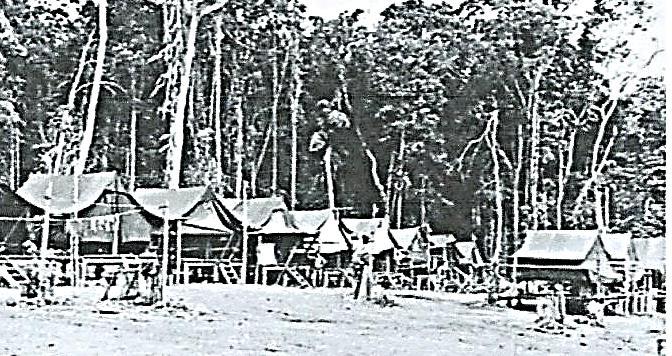

Base
Camp New Guinea Photo Credit State library of South Australia
Australian Sawmill Lae Photo Credit State library of South Australia.
Barking logs Lae Photo Credit PNGAA Frances Laker Collection. Photo credits Australian War Memorial
56
Busu Forest, Lae area, New Guinea. 1944 07 26. members of the 2/3rd forestry Company, Royal Australian Engineers, felling a tree from springboards. The "bush bosses" are attempting to teach the natives how to do it their way.

Lae, New Guinea. 1944 07 26. A member of 2/3rd Forestry Company explaining to Australian New Guinea Administrative Unit (ANGAU) natives the correct method of using a crosscut saw, in the Busu Forest.
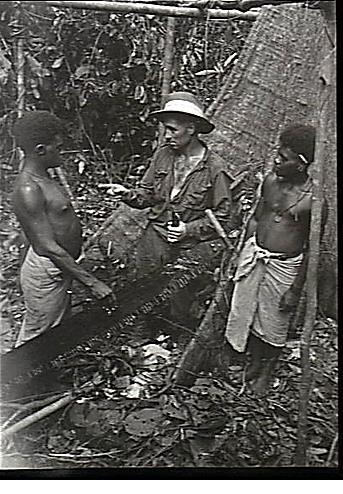
57
Lae
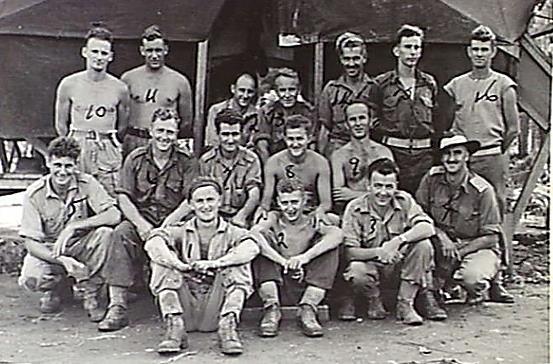
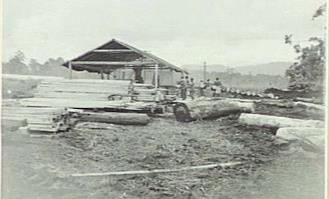
58 194553 . Yalu
6/8/1944. The portable sawmill unit of the 2/3rd Forestry Unit. Photo credit Australian War Memorial (maybe a Saxton mill but unsure).
53
31
Yalu sawmill 30/7/1945 Headquarters Platoon 2/1 Forestry Coy. Photo credit Australian. War Memorial.
Ref: PNGAF Mag # 3 of 3/11/20 p
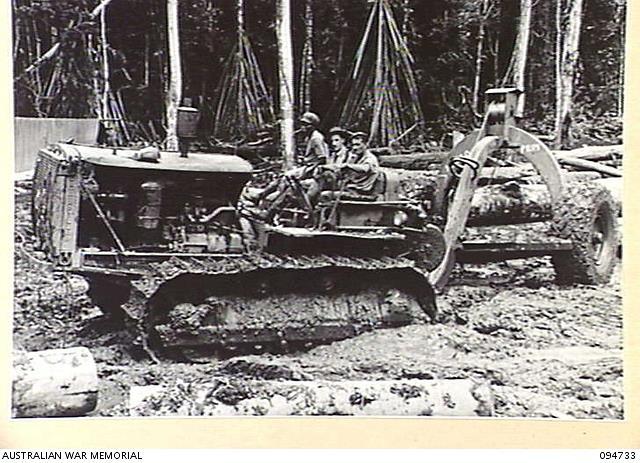
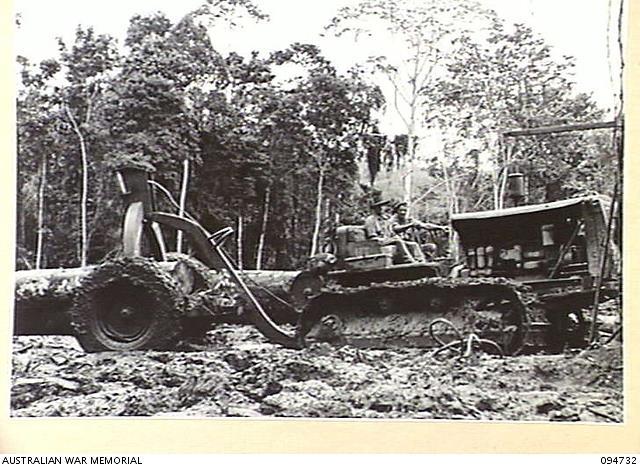
59
Yalu area, New Guinea, 1945 07 30. logging arch and d8 tractor operated by no. 2 platoon, 2/1 forestry company, Royal Australian engineers.
YALU AREA, NEW GUINEA, 1945-07-30. AN M 20 CRANE BEING OPERATED BY MEMBERS OF NO. 3 PLATOON, 2/1 FORESTRY COMPANY, ROYAL AUSTRALIAN ENGINEERS.


60
LAE, NEW GUINEA. 1944 12 21. CAPTAIN G W BROWN, (1), AND LANCE CORPORAL T A YOULTEN, (2), 2/3 FORESTRY COY ALONGSIDE A LOG LOADED BY BULLDOZER ONTO A TRUCK AT THE UNTHANK MILL.
YALU AREA, NEW GUINEA, 1945-07-30. THE CANADIAN BREAKING DOWN SAW AT NO. 2 PLATOON SAWMILL, 2/1 FORESTRY COMPANY, ROYAL AUSTRALIAN ENGINEERS

YALU AREA, NEW GUINEA, 1945 07 30. PERSONNEL OPERATING NO. 1 BENCH, 2/1 FORESTRY COMPANY, ROYAL AUSTRALIAN ENGINEERS,

61
LAE, NEW GUINEA. 1944-08-11. GENERAL VIEW OF THE SAWMILL OF THE 2/3RD FORESTRY COMPANY. IDENTIFIED PERSONNEL ARE: - VX52515 CAPTAIN J.G. SAXTON (1); QX150032 SAPPER KERR (2); QX19131 LIEUTENANT E.J. BATES, OFFICER- IN- CHARGE (3).
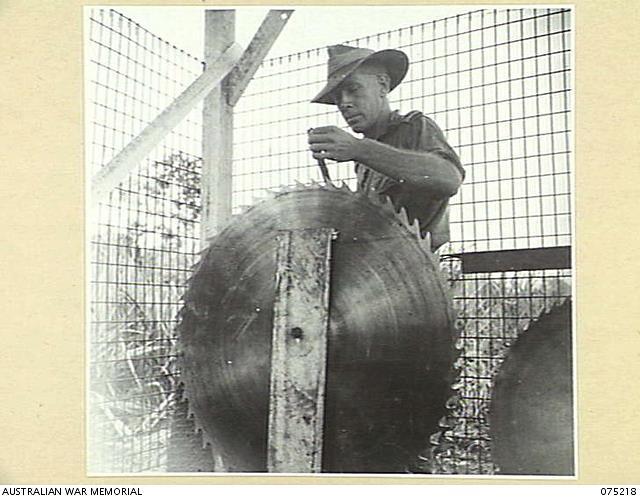
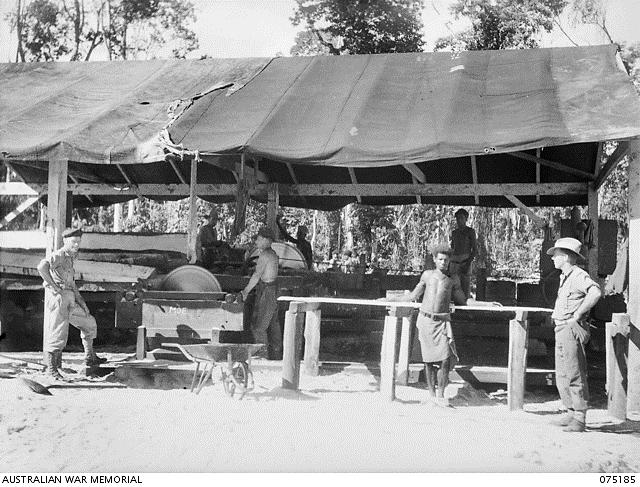
62
Lae New Guinea 6/8/1944 Lt E J Bates QX19131 Section leader of 2/3 Forestry Coy filing teeth of a large circular saw in Unit Workshop. Photo credit Australian War memorial
TPNG
Photo credit Cliff Southwell.
Douglas Henry Munro service number QX7257; rank Lieutenant. he was born in 1909 at Kyogle NSW. He enlisted at Kelvin Grove Queensland. After World War 2, he worked at the sawmill at Yalu via Lae before moving to the Regional Office Lae


63
Officers outside mess of 2/3 Forestry Coy. Lae NG 21/12/1944. #1 Capt. G Brown; # 2 Lt E J Bates; #3 Lt D H Munro (TPNG Forests); # 4 Capt. J Saxton; # 5Lt K L Ross; # 6 Lt C L Cameron; # 7 Major HR Parke Officer Commanding.
Photo credit Aust War Memorial.
Forests 1960’s Doug and Dulcie Munro

64 https://trove.nia.gov.au/newspaper/article/48947635? 02 Mar 1945 The Courier Mail Brisbane Qld 1933 1954 Page 4 “Axemen do Big Job in New Guinea.”
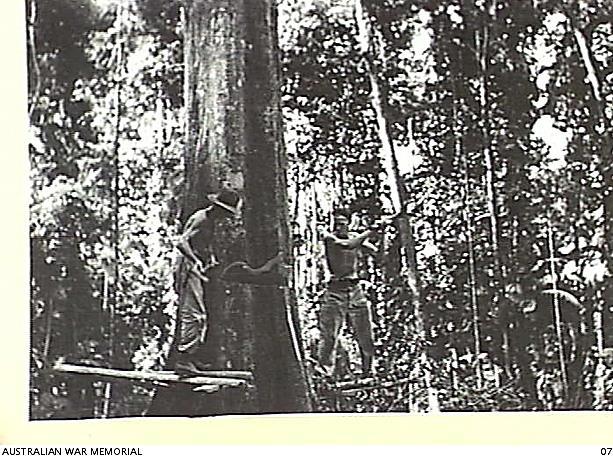

65
Torokina area, Bougainville Island. 1945 02 10. Sapper G. Burke (1) and Sapper F I. Blanch (2) no 3 platoon, 2/2nd forestry company scarfing a large tree before felling.
Bougainville Island, 1944 11 17. wx2773 Sapper McKinnon (1) and wx15927 Lance Corporal N M Treloar 2/2nd forestry company, using a crosscut saw to fell a large tree Photo Credit Australian War Memorial

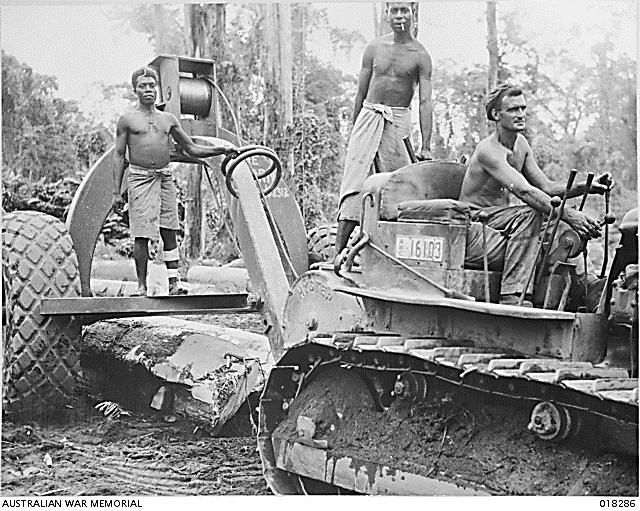
66
Cross Cutting logs ready for extraction. Photo credit Australian War Memorial
Bougainville. Corporal Dave Hughan of Jarrahwood, WA, drives the tractor dragging great logs into the Australian Forestry Unit sawmill. Two native men help the operations.
TOROKINA AREA, BOUGAINVILLE ISLAND. 1945 02 10. SAPPER A.W. GLASSBY (1) AND SAPPER F.S. MCARTHUR (2), NO 3 PLATOON 2/2ND FORESTRY COMPANY USING A CATERPILLAR TRACTOR TO HAUL A LARGE LOG TO THE UNIT SAWMILL.
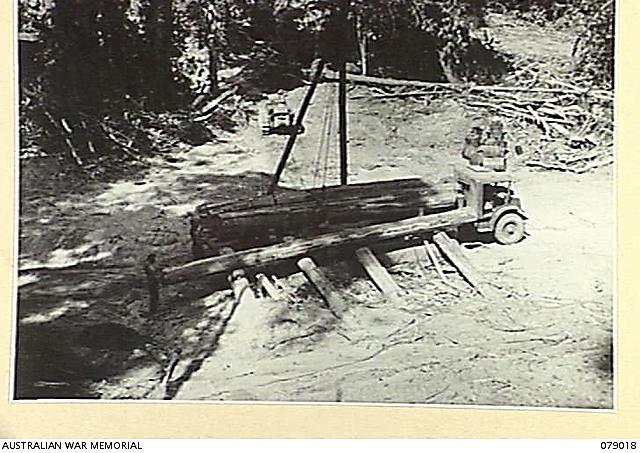
TOROKINA AREA, BOUGAINVILLE ISLAND. 1945 02 10. SAPPER E. HAYNES, NO 3 PLATOON 2/2ND FORESTRY COMPANY USING A CATERPILLAR TRACTOR TO LOAD LARGE LOGS ON TO A TIMBER JINKER
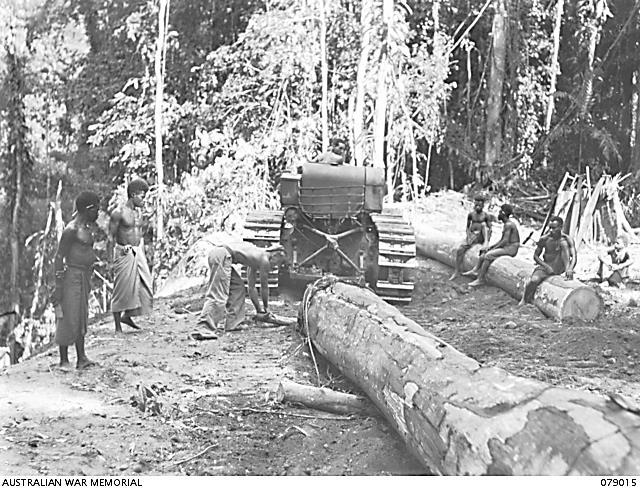
67
BOUGAINVILLE ISLAND, 1944 11 17. PERSONNEL OF THE 2/2ND FORESTRY COMPANY ROLLING A LARGE LOG ONTO THE LOG TROLLEY AT THE UNIT SAWMILL. IDENTIFIED PERSONNEL IS: WX15926 SAPPER V.R. RAPER (1).
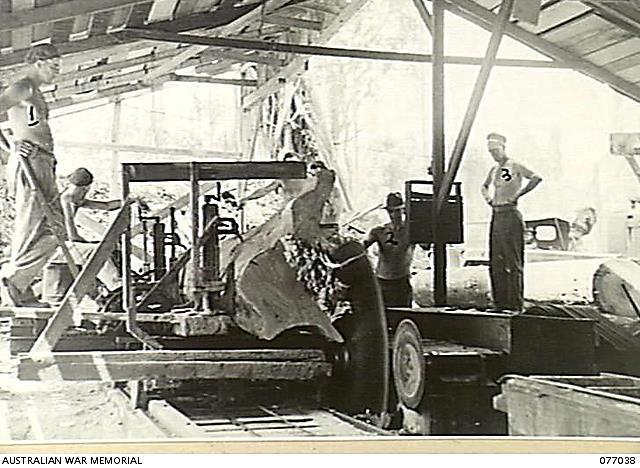
.
BOUGAINVILLE ISLAND, 1944 11 17. PERSONNEL OF THE 2/2ND FORESTRY COMPANY CUTTING A FLITCH FROM A LARGE LOG AT THE UNIT SAWMILL. IDENTIFIED PERSONNEL ARE: - NX163574 SAPPER G.D. BROWNE (1); WX2758 STAFF SERGEANT W.A. COLLINS (2); QX56027 SAPPER H. EDWARDS

68
BOUGAINVILLE ISLAND, 1944-11-17. THE SAWMILL, OF THE 2/2ND FORESTRY COMPANY. IDENTIFIED PERSONNEL IS: - VX90808 SAPPER M.F. CONDRON (2).
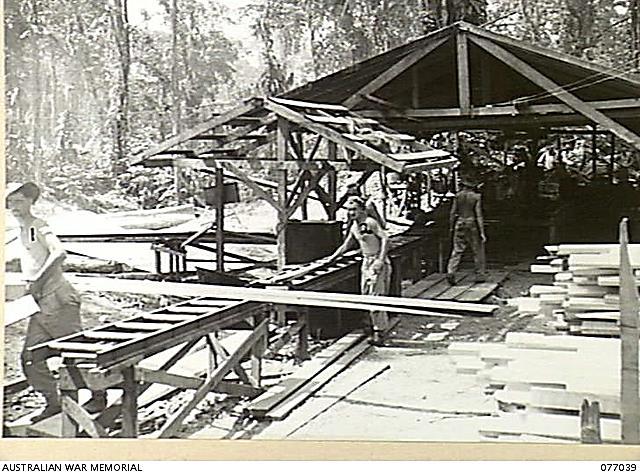
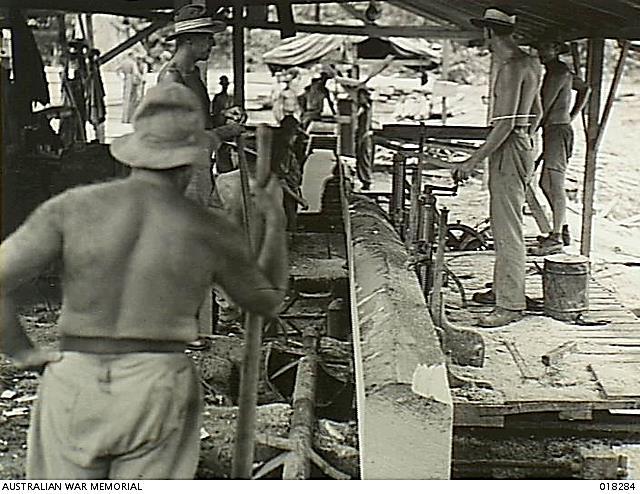
69
Bougainville Australian Forestry Unit sawmill in operation with band saw
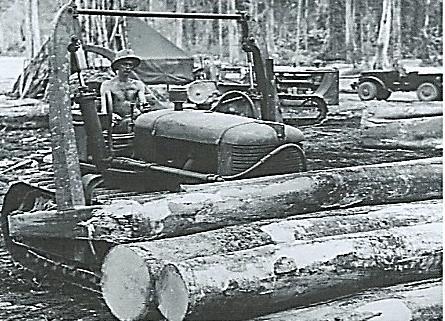
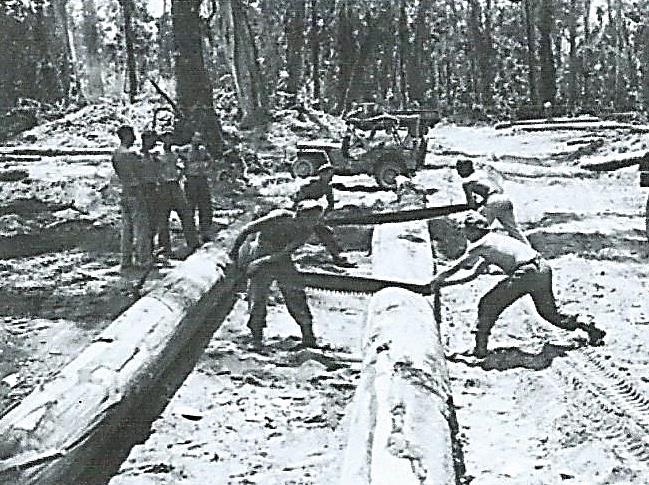
70
John Henry (Jack) Meagher from Karragullen driving a bulldozer in Torokina Bougainville. Photo credit Australian War Memorial.
Sawing logs in New Britain presumably at Jacquinot Bay Photo Credit Aust War Memorial.
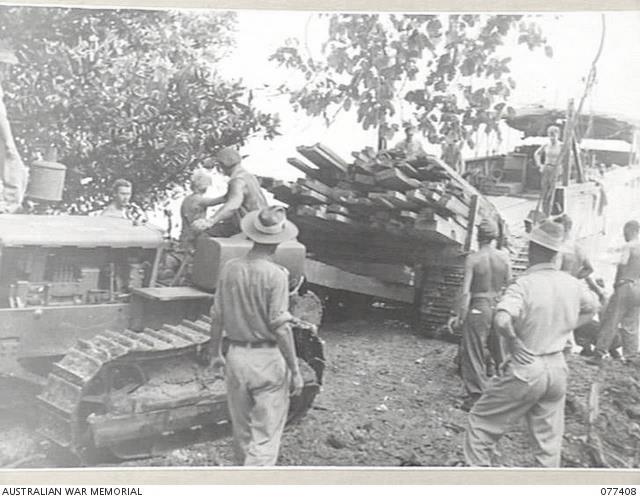
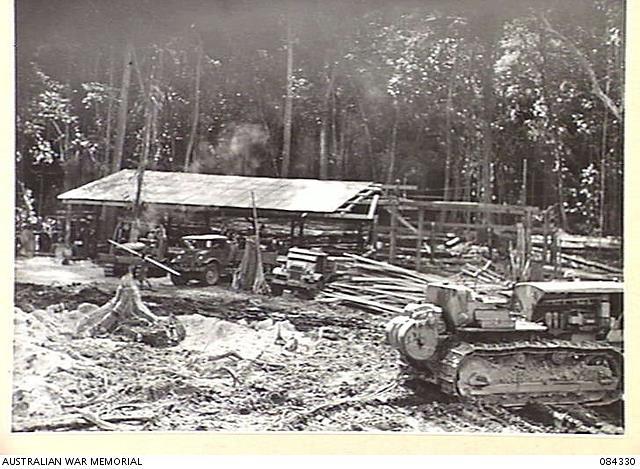
71
CAPE CUNNINGHAM, NEW BRITAIN. 1944 11 29. SAWN TIMBER BEING LOADED ABOARD A LANDING BARGE BY PERSONNEL OF THE 2/2ND FORESTRY UNIT.
CAPE
CUNNINGHAM, NEW BRITAIN, 1944-12-16. THE 2/2 FORESTRY COY SAWMILL LOCATED IN A HEAVILY TIMBERED AREA AT CAPE CUNNINGHAM NORTH.

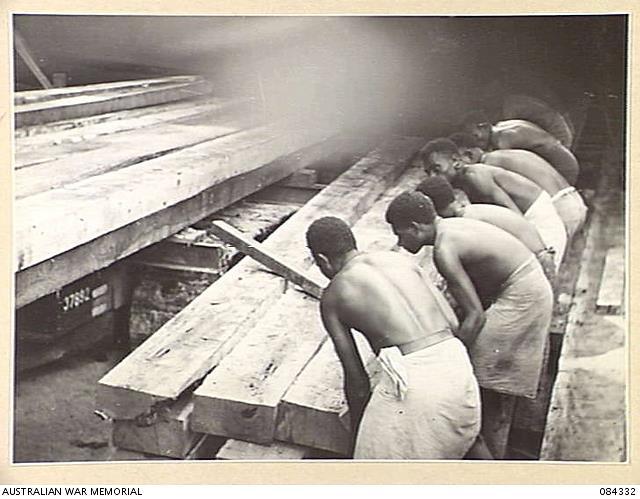
72
CAPE CUNNINGHAM, NEW BRITAIN, 1944-12-16. SAPPER A W HEYWOOD, 2/2 FORESTRY COY, ASSISTS MANAM ISLAND NATIVES AS THEY ROLL LOGS TO THE SAW BENCH
Cape CUNNINGHAM, NEW BRITAIN, 1944 12 16. NATIVES FROM MANAM ISLAND AT THE 2/2 FORESTRY COY SAWMILL STACKING SAWN TIMBER ON A TRAILER. Photo credit Australian War Memorial
In a paper presented to the Fifth National Conference on Australian Forest History54 by Judith A. Bennett, Department of History, University of Otago, New Zealand titled “Allied logging and milling in Papua New Guinea during World War 11 describes in some detail following the war, the compensation program undertaken by McAdam and his officers between 1947 and 1960, paying customary owners for the timbers harvested during the war.
55Note the format for TPNG patrol reports included a section on war damage compensation for applicable customary owners.

54
in 2002 ISBN 0867405309
55 https://library.ucsd.edu/dc/object/bb9046273d/_1.pdf
73
Fifth National Conference on Australian Forest History edited by John Dargavel, Denise Gaughwin and Brenda Libbis
1946 WAR EFFORT REBUILDING Sawn Timber
At the end of the war, as far as can be ascertained, some 80 odd million super feet of sawn timber had been produced by these units. In addition, the forests had yielded thousands of pieces of round timbers for escarpments, corduroy, bridge timbers, telephone poles, firewood, and the many other needs of a vast army. It was roughly estimated that this effort had saved two million pounds worth of Australian timber and over three quarters of a million pounds worth of shipping space. Figures, of course, would be very much higher at present day prices. The cessation of hostilities in 1945 found that all the towns, with exception of Port Moresby, in ruins. Salamaua, Lae, Rabaul, and Madang were destroyed. Given the demand for timber in Australia and the scarcity of shipping space, it was necessary that the bulk of timber required for reconstruction be produced locally.
Rabaul after capture 1945. Much damage caused by allied bombing Oct 1945.

Photo credit Australian War Memorial
This devastation, coupled with a revised policy of economic development, created an immediate need for sawn and seasoned timber. To facilitate the rapid rebuilding of the major towns, the Provisional Administration established and operated through the TPNG Department of Forests, sawmills using war surplus equipment and staffed largely by personnel recruited from the wartime Army Forestry Units. 56
Two war time sawmills at Kerevat and Yalu sawmill near Lae were taken over by the Administration and operated by the Department to supply sawn timber and to acquire information on local timbers which would be of practical benefit in the development of a local commercial timber industry. One sawmill closed in 1960 and the other in 1961. By 1952, the local sawmilling industry had reached the stage where it was able to meet the local demand i.e., mill output around 24 thousand cubic metres per annum.
74
56 J B McAdam 1952:” Forestry in New Guinea” Paper to Papua & New Guinea Scientific Society’s Annual Report
Yalu57 had no houses after the war and these houses were built from scratch with timber from the local area. 4 5 houses and a singles quarter.
TPNG Dept of Forests Housing Yalu after World War 2. Photo credit Cheryl/Norma Collis 1946.


Photo
Yalu
Ted Collis during World War 2, Ted served as a corporal in the 2/1 Australian Forestry Company In 1946, Ted was approached by Jim McAdam to go back to New Guinea to help rebuild Lae. Ted said “no way not going back to that place” but was persuaded when he knew other army mates were going.
He ended up in Yalu 20 miles out of Lae at a sawmill. The only army mates that Norma Collis recalls
75
1946 -1955 TPNG Forests Yalu Sawmill
1946 TPNG Dept of Forests Sawmill crew Yalu after World War 2. Although unclear personnel included Ted Collis, Alan and Ken Fraser, Col Pittaway, John Thompson, Eric Dobson, Bill Jenkin, George Barrcroft, Darby Munro.
credit Cheryl/Norma Collis.
ex WW 2 Forestry TPNG Forestry staff included:
were George Barrcroft, Darby Munroe, Alan and Ken Fraser, John Thompson, Eric Dobson, Col Pittaway, and Bill Jenkins. Yalu had no houses, and these were built from scratch
57 Personal communication Cheryl and Norma Collis
with the timber from the local area 5-6 houses were built and a singles quarter. When the mill closed in Yalu in 1955, everyone moved to Lae to a new mill.
The Lae government sawmill58 became beset with problems and was placed under regional control. The main problem was the lack of logs, but with the aid of a few young field officers and agreat deal ofenthusiasm bymill workers, additionalresources were found,designedroads to tap them and make the mill profitable. This, however proved the mill’s undoing as it became competitive with private industry and in accord with policy of the day it was closed. It was converted into the Transport Department garage and later to the Lae Produce Market. Its staff and equipment were dispersed through the department. Many of the staff stayed with the Department in Lae, Bulolo and Port Moresby. Ted chose Bulolo where he was put in charge of the nursery responsible for a million and quarter pine klinkii and hoop trees to be planted out in the plantation every year.
L to R Dick McCarthy, Ted Collis and Kevin White Mid 1970’s Bulolo Plantations. Photo credit John Davidson.

Col Pittaway was an NSW VDC man discharged in December 1943 when only 18. After World War 2, he worked at the sawmill at Yalu.
George Henry Barrcroft enlisted on 9 April 1941. He was a sapper in 2/3 Forestry Coy. He was discharged on 27th October 1945.After World War 2, he worked at the sawmill at Yalu.
Bill Jenkin arrived in PNG in October 1949 after four years serving with BCOF Occupation Force in Japan to the sawmill at Yalu as a tractor operator/Mechanic. 1951 when he left to serve in Korea. 1953, he returned to PNG working as a forest ranger, District Forester, then Harvesting and Marketing Officer in Port Moresby He studied accounting, 1968 joined the Transport Department TPNG., December 1975 he moved to Tasmania, working as an accountant until retirement in 1994
Ken Fraser enlisted on 23 May 1942 in Adelaide and discharged on 5 October 1945.He was a corporal with RAAF at Air Defence HQ Port Moresby. After WW2, he was at Yalu sawmill and then as a forest ranger.
Alan Fraser enlisted on 25 May 1940 at Maryborough and was discharged on 27 July 1945. He was a private and prisoner of war in Germany. In NG, he was in the 2/15 Infantry Battalion. After WW2 he was at Yalu sawmill and then technical officer and OIC at Kerevat plantations and then moved to Bulolo plantations.
76
58 Reference PNGAF Mag # 9B 5B4M2 of 27th July 2021 Eminent TPNG forester Don McIntosh.
1946 - 196159 . Kerevat Sawmill New Britain
Jim Cavanaugh visited New Guinea in 1938 and joined the New Guinea Public Service in 1940. In 1941, he enlisted and served first with the New Guinea Volunteer Riflemen (NGVR) and later with the 2nd Australian Forest Survey Company. He also conducted intelligence work with the Central Bureau. He spent almost all the war years outside Australia often behind Japanese lines. He was a commissioned officer and was demobilised in December 1945.
Linda Cavanaugh Manning reported that in January 1946, Jim returned to Papua New Guinea as a forester and was put in charge of the Northern Region. He was based in Kerevat near Rabaul, and he set himself the task of getting the sawmill at Kerevat working to produce timber to rebuild the town of Rabaul after the ravages of the war. When he needed engines and gearboxes, Jim converted abandoned Japanese motors and gearboxes to power the mill. He initially ran a team of Chinese labourers that had been abandoned in Rabaul by the Japanese army and later a team of Papuan New Guineans. Pat, his wife, did the books.
#1 Derelict Kerevat Sawmill as at 1967-68. # 14 Remnants of the old sawdust heap from the mill.
Photo credit J D Davidson.
60Don McIntosh reported that in 1952 his first posting was Kerevat where his main task was to establish plantations of teak and kamarere in the wake of the government sawmill logging. The sawmill manager was Ted Roach, who supplied most of the timber needs of Rabaul until the early 1960’s when the task was taken over by private concerns such as Gazelle Timber Co. and Nonga sawmills. The government mill became a research and training unit.

Another Kerevat sawmill manager was Dick Reilly who enlisted on 20 April 1941 and was a sapper with 3 Forestry Coy. He was discharged on 26th April 1944.
59 Ref: PNGAF Mag # 3 of 3/11/20 p 73, 103
60 Reference PNGAF Mag # 9B 5B4M2 of 27th July 2021 Eminent TPNG forester Don McIntosh.
77
61Peter Eddowes recalled in 1961 at Kerevat that he worked with Dick Riley, Ken Skyring and John Smith, (not the forester) who helped to skill him in the operations of the machinery as well as tree/log identification These men were hard, tough Bushmen, with Dick hailing from the timber area of Dorrigo in NSW where he did the hard yards in felling of trees with an axe, and then, the cutting and adzing to size, of hardwood sleepers. Ken was from the forest area of Gympie where he worked in logging and roadbuilding. Les Austin ran the machinery workshop, and Arthur Mobbs and Norm Hillary (Saw Doctor), who managed and ran the Government forestry sawmill The logs that were felled were sold to the local saw millers in Rabaul incl., Ben Cheong, Dick Gault and, then there was Jack Chipper,’ the so called Lord Mayor of Rabaul. Who was this guy (Jack Chipper) that had the audacity to drive around the small township of Rabaul in a bloody ‘gold’ Rolls Royce”?
Part of old sawmill 1995. Photo credit Dick McCarthy. Foreground balsa logs. Background depository of used government vehicles.


Kerevat Sawmill 1946 Pat Cavanaugh standing near one of the stacks of sawn timber.
Photo credit Linda Cavanaugh Manning
78
61 Forthcoming publication re eminent TPNG Forester/wood technologist late Peter Eddowes Reflections of past times in PNG Forestry submitted 27/6/2018.
Part of the sawmill equipment Kerevat Sawmill 1946. Photo credit Linda Cavanaugh Manning.





Jim and Pat Cavanaugh’s retirement from Dept of Forests in 1972. Director Don McIntosh is standing behind Pat.
Photo Credit Linda Cavanaugh Manning
79
One of the saws in Kerevat Sawmill 1946. Photo credit Linda Cavanaugh Manning
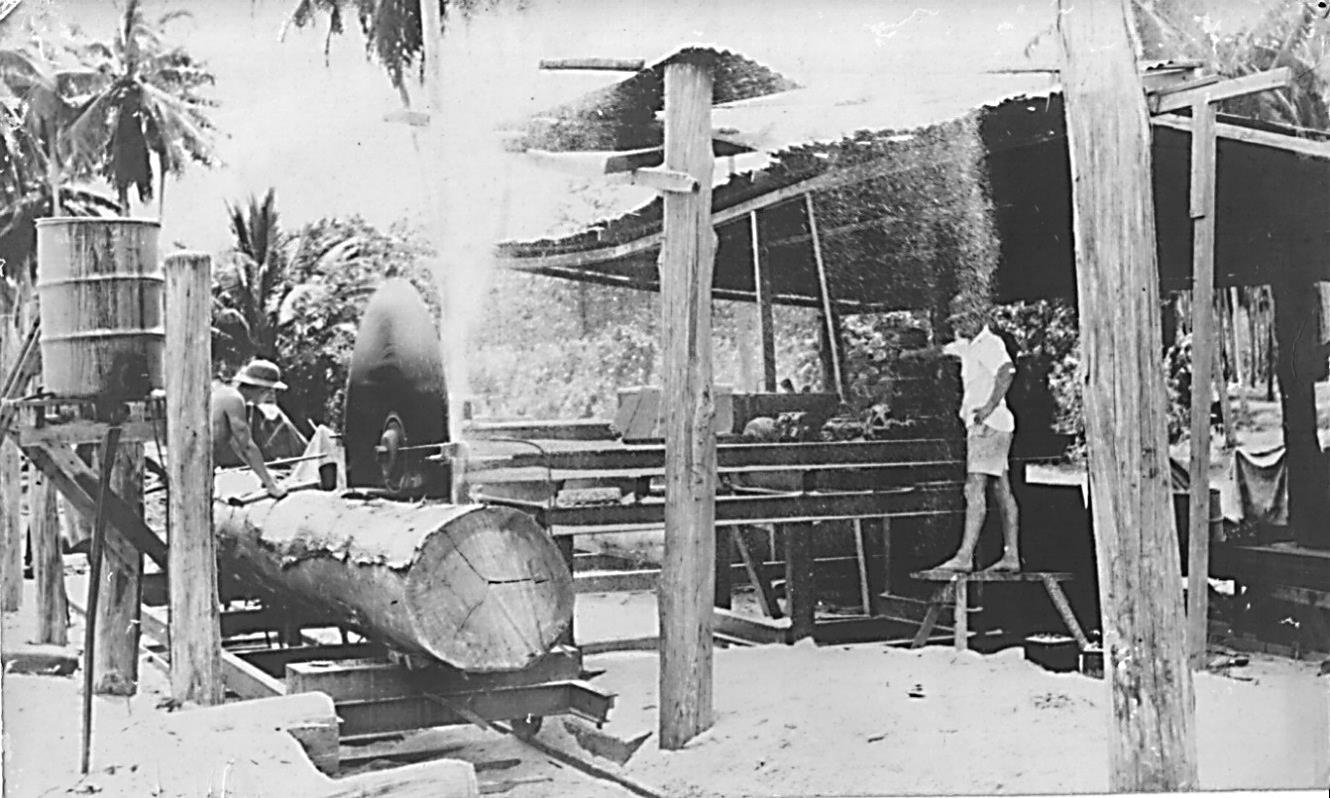
80
1946. NUMA NUMA SAWMILL Bougainville. This sawmill operated just out of Numa Numa on east coast Bougainville after WW2 Source OIES dated 1960s. Michael Pearson.
New Guinea Timbers. Acting in close co operation with the New Guinea Forests Department, the Division proposes to continue and extend the work on the examination of physical and mechanical properties of New Guinea timbers. Wood Structure Section. This Section has made a comprehensive study of the macroscopic and microscopic characteristics of Australian timbers and has applied the results of its work to identification keys on the one hand and to certain features of investigation of other sections on the other. During World War II, card sorting keys developed for the timbers of the Pacific Islands were of considerable aid to the Allied forces fighting in that zone. Wood Chemistry Section. continues the work of the pulp and paper investigations initiated by the old Forest Products Laboratory. Timber Physics Section fundamental research into the physical properties of timber. Timber Mechanics Section. mechanical properties of various Australian timbers, bending properties of Australian timbers, projects designed to meet the need of materials for housing. Seasoning Section. Major activity developing a high standard of kiln drying in Australia Preservation Section. field tests of poles, sleepers, and fence posts treated with various preservatives; responsible for the boric acid treatment of lyctus susceptible timbers. Veneer and Gluing Section. Assistance in the peeling, drying, and gluing of Australian timbers. Work on adhesives Utilization Section.
Update 2018 re CSIRO/PNG Wood Research by the late Peter Eddowes63
Peter Eddowes in 1965 spent a period three months, at CSIRO, to study the wood anatomy of timbers, under the tutelage of Bob Ingle (Wood Anatomist). Peter had been working in close association with Bob since the collection of materials started for testing by CSIRO. During this period, Bob would receive, from Eddowes, small wood blocks of duplicate wood material from the (authentic) ‘NGF’ series, of wood collections. From these wood samples, Bob then prepared a full collection of microscopic slides which were invaluable in the support identification and authenticity, of the wood material as collected for testing by CSIRO.
Peter Eddowes advised that PNG relied heavily upon local sawmills to mill the wood samples, as collected in their area, for ongoing research purposes, and in the cutting of the flitches of the collected (authentic) materials for consignment to the CSIRO in Melbourne Sawmillers included Jack Lindquist (Amplex / New Britain, Golden Pines / Bulolo, Wau sawmills), Vince Sanders (Brown River), Bill McLellan (Lae), Jack Eustice (Oriomo), Ed Fitzgerald (Madang), Bert Counsel (Ihu / Gulf), Bill Bailey (Open Bay / New Britain), Simon Hirata (Stettin Bay / New Britain), Jack Thick (Lufa / Goroka), Don Neate (Woodlark Island), Ron Neville (Mendi), and the Stewardson brothers (Normanby Island/ Milne Bay).
Peter Eddowes advised that in the period (1961 1975) they achieved their goals in the collection of materials, to determine both the physical and mechanical properties of the major timber species. The team of John Colwell, Greg McDonald, Barry Hartwell, Maru Kumul and Peter Eddowes, together with the members of the Division of Building Research CSIRO, including Nora Bolza, Bob Ingle, Bill Keating et al, was responsible for establishing a true record for the properties and potential uses for the major commercial timber species of Papua New Guinea.
62 Extracts article by G Rodger Unasylva Vol 1 # 3 Nov Dec 1947 FAO.
63 Forthcoming publication re eminent TPNG Forester/wood technologist late Peter Eddowes Reflections of past times in PNG Forestry submitted 27/6/2018.
81
1947 Research Work CSIR in Forestry & Forest Products Australia/ PNG 62
AFS Class 1943 1944. L to R. Dick Woods (SA) awarded Schlich Medal, Alan McArthur (NSW), Bill Hindmarsh (NSW), Bill Heather (NSW), Hugh Bell (NSW).

Source ANU AFS archives.
Bill Heather was born in Ashfield NSW in 1923 and died in 2004.65 He graduated from AFS in 1944.
Bill Heather (TPNG Forests 1947 1955) was a Regional Forest Officer at Rabaul New Britain in the late 1940’s and early 1950’s in Papua New Guinea. He and forest ranger W R Fryar started the Kerevat Forest plantation program with Eucalyptus deglupta (Kamarere) at Kerevat New Britain in 1948. 66

Donald Fryar service number SX2836: born in 1919 in Adelaide SA. He enlisted at Wayville SA. He was a forest ranger Kerevat until killed in the late 40’s/early 50’s. in an accident on the Kerevat River Bridge. Fryar logging area in Kerevat is his legacy.
Bill heather undertook plant collections from Sogeri (Papua) and New Britain in the NGF series (CF New Guinea Forces Lae after 1945.)
82
1947 Bill Heather64 TPNG Forests 1947-1955
1948 E deglupta (Kamarere) Kerevat ENB planted by Bill Heather.
Photo credit John Davidson 1972.
64 Reference PNGAF Mag # 9B 5B4H5 eminent TPNG Forester Bill Heather 25th July 2022 65 Heather, William Gungahlin, Wednesday, December 29, 2004, Saturday, June 2, 2007, PB 08 05 00 314
66
John Davidson personal communication
In 1955 Bill Heather published Heather, W. A. (1955). The Kamarere (Eucalyptus deglupta) forests of New Britain67 This paper descibed the environmental conditions under which E deglupta occurs naturally in New Britain. Silvicultural characteristics and requirements of the species are outlined. A silvicultural system and policy of management are proposed. Information on growth, yield, major properties and uses of the timber is summarised.
After service in PNG, Bill Heather became lecturer in forest pathology, wood science (technology) and Silviculture at the Australian Forestry School.
Bill Heather’s thesis in 1965 for his Ph.D. was on: Some aspects of the ecology and pathology of phaeoseptoria eucalypti Hans. emend. Walker on some species of the genus eucalyptus Heather, William Aloysius
Keywords: Eucalyptus Diseases and pests.; Eucalyptus.; Leaves Diseases and pests. on some species of the genus eucalyptus / W.A. Heather. Some aspects ...Online at https://openresearch repository.anu.edu.au/handle/1885/142333
Of interest is the reporting68 of Bill’s wedding to Norma Foster in 1951 in Narrandera. St. Mel's Church, Narrandera, was beautifully decorated on 2nd June for the marriage of Norma Aileen Foster, third daughter of Mr. and Mrs W. Foster, of Narrandera, and William A. Heather, eldest son of the late Mr. W. Heather, and Mrs. A. G. Heather, of Strathfield. The Rev. Father McVeigh, P.P., assisted by the Rev. Father Stempter, M.S.C., of Viamona, New Britain, officiated at the Nuptial Mass
On the 16th of June they sailed on the 'Bulolo' for Rabaul, their future homeland. A week previously the bridegroom's mother sailed for Rome to attend the ordination of her youngest son.
TPNG’s MAIL BOAT
HMS Bulolo was a 6,267ton passenger and cargo ship of the Burns, Philp Shipping Company operating in the South Pacific. Her shipping route was Route Mail service from Australia to PNG including Solomon Islands, New Hebrides, Norfolk, and Lord Howe Islands.

Source Wikipedia.
67 Heather, W. A. (1955). The Kamarere (Eucalyptus deglupta) forests of New Britain67. Empire Forestry Review, 34: 255 278.vol 3 68 http://nla.gov.au/nla.news article101621436
83



84
ANU Department of Forestry 1969. John Davidson (fourth from left back row), Bill Heather (third from right, middle row.)
Photo credit John Davidson.
69 John Davidson’s Wood Density Researchon E deglupta. Part of his Ph.D studies.
69 Reference PNGAF Mag # 9B 5B4D3 of18th Aug 2022 Eminent TPNG Forester John Davidson 1962 1980.
1948-1963 AUSTRALIAN TPNG FORESTER CADETSHIP SCHEME
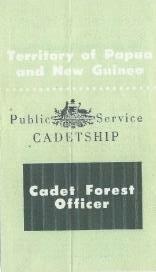
After the Second World War, a cadetship scheme was undertaken by the Australian Department of Territories to train Australian Forest Scientists to ensure sufficient professional staff for the purposes of creating a functional Forest Department for TPNG
Surname Positions TPNG Cadetship AFS Year graduation
Edward Charles Gordon Gray (NG)
Alexander John Hart (NG)
Donald Henry McIntosh (NG)
Kevin Joseph White (Q)
1948 1946 1946 Qld
1950/51 1950/51 1950/51 1950/51
1952 1952 1952 1952
Robin Levingston (NSW) 1952/53 1954
Jaroslav Joseph Havel (WA) 1953 1953/54 1955
Robin Bilbrough Morwood (NG) 1952 1955/56 1957
Frank Harry Coppock (NG)
Elliot Carby Tuckwell (NG) 1953 1953 1956/57 1956/57 1958 1958
John Godlee (NG) 1954 1957/58 1959
Ian Grundy (NG)
Eric Hammermaster (Q/NG) Des Harries (NG)
Gerry Vickers (NG)
Alan Cameron (Q)
John Smith (NG)
Brian O’Hagen (NG)
1955 1955 1955 1955
1956 1956 1956
1958/59 1958/59 1958/59 1958/59
1959/60 1959/60 1959/60
1960 1960 1960 1960
1961 1961 1961
Alan White (NG) 1960 1960 1960/61 1960/61 1962 1962
Neil Brightwell (NSW)
Leon Clifford (NSW)
Evan Shield (NG) 1958 1958 1961/62 1961/62 1963 1963
John Lake (NG) 1962/63 1964
Ian Currie (NG) 1963/64 1965
John Harrison (NG) Medi vac out
Chris Borough (NG) field year
Bob Bruce (NG) no field year
Rex Grattidge (NG) no field year
John Davidson (NG)
Paul Ryan (NG)
Rod Holesgrove (NG)
Jim Belford (C)
Dick McCarthy (NG)
Dave Num (C)
Bob (R G) Lyons (NG)
Gary Archer (NG)
Chris Done (NG)
Ken Hart (NG)
Ian Whyte (C)
Last field year for cadets 1961 1960 1961 1961
1962 1962 1963
1966 1963 1965 1965
1966 1966 1963 1966
1964/65 1964/65 1964/65 1964/65
1965/66 1965/66 1965/66
1966/67 1966/67 1966/67 1966/67
1967/68 1967/68 1967/68 1967/68
1966 1966 1966 1966
1967 1967 1967
1968 1968 1968 1968
1969 1969 1969 1969
85
Footnotes. TPNG Territory of Papua New Guinea; NG New Guinea, Q Qld. WA Western Australia; NSW New South Wales; C Commonwealth. AFS Australian Forestry School; BFC Bulolo Forestry College
FAO reported on forestry in the territories as under the administration of the Department of Forests of the Territories in conjunction with the Commonwealth Forestry and Timber Bureau of Australia. They have a land area of over 46 million hectares (115 million acres) about equally divided between Papua and New Guinea. Together they are 60 to 70 percent forested. The population is in the neighbourhood of a million. Forest types include the lowland rain forest from sea level up to about 700 meters (2,000 ft.) elevation. The midmountain forest consists of Araucaria and oak; and the mossy forest at 2,300 to 3,500 meters (7,000 to 11,000 ft.) elevation is composed of Nothofagus, Phyllocladus, Dacrydium, Libocedrus, and Podocarpus. There are also some swamp forests and savannah types of little economic value except for mangrove. The lowland rain forest resembles the mixed dipterocarps of Indonesia, the Philippines, Indochina, and Malaya. The Araucaria resembles that of north eastern Australia, and the mossy forest is similar to the indigenous type of New Zealand. The ownership of forest land remains with the inhabitants either as individuals or as village groups. Government ownership must be obtained through purchase from the inhabitants before territorial forest reserves can be established.
There has been extensive coverage of the territories by aerial photographs taken during the war. There has also been considerable botanical collection and classification work by the Australian Forest Products Laboratory of the Council for Scientific and Industrial Research at Melbourne, and by the State botanist of Queensland in Australia. There are, however, only very rough estimates of the volume of timber in the territories. Such estimates place the rain forests at 38 to 114 m3 log volume per hectare (640 to 1,630 cu. ft. per acre) and the Araucaria oak forest is said to carry about 1.1 million m3 (40 million cu. ft.) over a total area of 15,000 hectares (37,000 acres). During the war, U. S. Army sawmills produced considerable quantities of lumber. There are now 11 sawmills operating which in 1947 produced about 21,000 m3 (740,000 cu. ft.) of lumber. The Australian government operates a sawmill to train local sawyers and some skilled labourers. As production expands, Australia hopes to meet not only the present annual requirements of the territories, but to obtain considerable quantities of hardwoods for Commonwealth use. Although pre war annual consumption of timber in the territories was not great, it is estimated that rehabilitation requirements will need almost 23,600 m3 (830,000 cu. ft.) a year for the next five or six years. Minor forest products include sago from the Metroxylon palm, nipa palm leaves for thatching, mangrove bark for tannin, dammar gum, canes, and bamboos.
Among the problems facing any forestry program in the territories, one of the most urgent is the control of shifting cultivation. Territorial forest reservations will have to be made to meet local demands and expanded export industries. A comprehensive inventory should be made, taking advantage of the excellent aerial photographs that are available. It will be necessary to secure trained foresters, and such training is being provided at the Australian Forestry School at Canberra. Plans are under way for a research program in silviculture through the Commonwealth Forestry and Timber Bureau, and in products through the C.S.I.R. at Melbourne.
86 1948 FAO PNG70
70 FAO in Unasylva Vol 2 # 6 1948 New Guinea and Papua
1949 ECONOMIC DEVELOPMENT PNG Potential of Wood Fibre
The potential of tropical hardwoods as a source of raw material for cellulose fibre has been recognised for many years. Commercial utilisation has been low in development especially for the technical problems involved with pulping such a mixture of tropical woods given the range of diverse properties which is characteristic of the tropical hardwood forest.
Cutch in PNG
Efforts to evaluate this type of forest resource for pulp and paper manufacture commenced in 1949. The impetus at this time was given by the commencement of a tannin extracting industry based on the mangrove forests of the Gulf of Papua, which threatened to lead to waste, vast quantities of timber following commercial stripping of the bark.
The bark extract, which is called cutch, is used to dye materials khaki and to preserve fishing nets. The bark extract, then made from a type of wattle in India, was used to colour British military uniforms khaki last century after the War Office had decided that the resplendent redcoats were too easily spotted by the enemy.
Cutch Factory, Aird Hills, Papuan Gulf. The steamer 'Narani' was used to transport processed cutch to Port Moresby in the early 1950s. Photo credit National Library of Australia
Perome is a small village near Aird Hills on the Delta of the Kikori River. Most of the Delta area is a flood plain largely supporting Sago Palm. Aird Hills is close to the Gulf of Papua
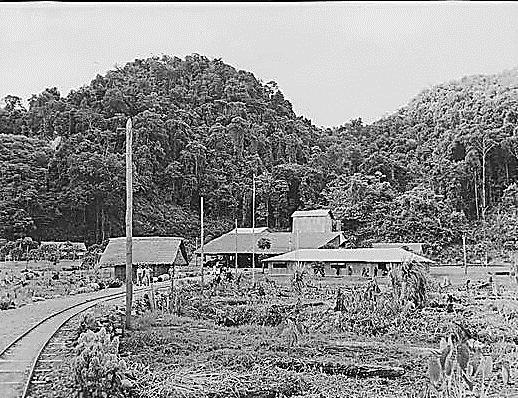
87
and deep-water access to the volcanic hills. It is these conditions that allow mangroves to flourish.

Narani was build by E Wright Tuncurry NSW. It was used as a auxilary minesweeper during WW2. (deleted from Lloyd’s register in 1955).
In 1951 Narani was sold to the New Guinea Borneo Mangrove Company and taken to Aird Hills in the Kikori River Delta, Papua. Her role was to transport cutch (bark harvested and processed) from mangrove trees Port Moresby. The cutch factory had a railway line to transport bark to the processing plant and processed cutch back to the Narani. In 1951 the Narani was purchased by the New Guinea Borneo Mangrove Co., Port Moresby
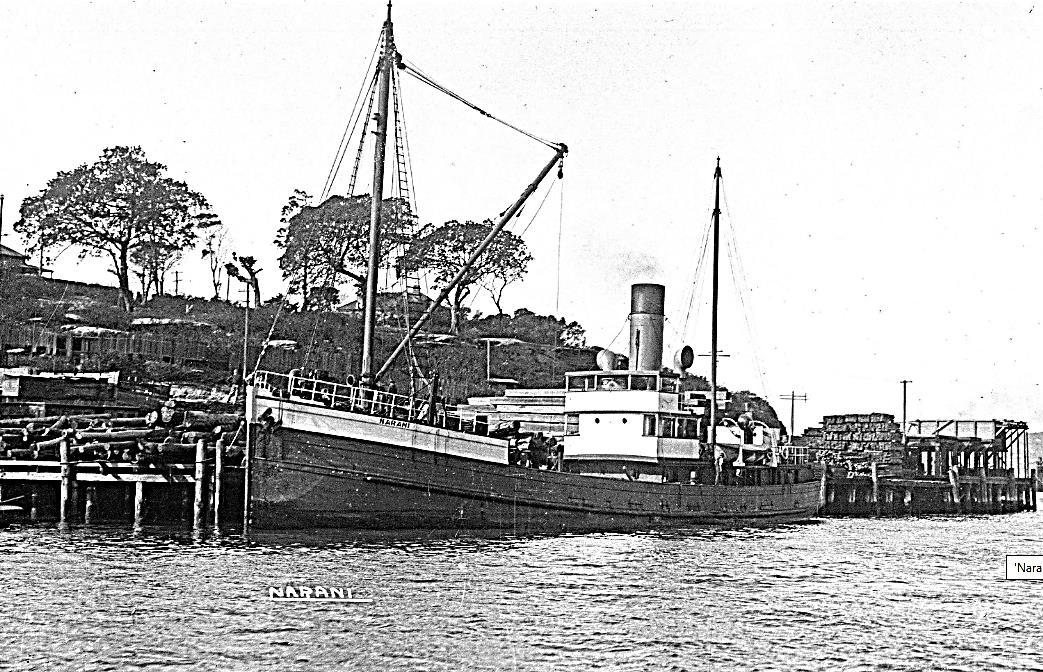
88
Gulf of Papua delta, Western Province. Photo credit Dick McCarthy 2004.
Wooden steamer Narani at Goat Island. Source Dufty Collection (Courtesy Graeme Andrews) GLMRSNSW (Great Lakes Manning River Shipping NSW)
The Australian Women's Weekly Wednesday 27 June 1951 published this account: "English couple Charles and Phyllis Cook left Sydney in the old N.S.W. coaster Narani recently, counting the days till they are back in the jungle. Mr. and Mrs. Cook are on their way to a river delta at Perome, 300 miles from Port Moresby, in Papua, where they will establish a factory to make a bark extract from native trees. The Cooks like jungle life. Before coming to Sydney, where their ship took on six months' supplies and equipment, they lived in Borneo. In Borneo Mr. Cook was managing a factory producing bark extract, which is called cutch, and is used to dye materials khaki and to preserve fishing nets. The bark extract, then made from a type of wattle in India, was used to colour British military uniforms khaki last century after the War Office had decided that the resplendent redcoats were too easily spotted by the enemy. Mr. Cook will use mangrove bark to make the extract in his Papuan factory. It is claimed that this type of bark produces the best dye."
Michael Pearson71 described PNG’s Great Train Robbery: "The Borneo New Guinea Mangrove Company established a pioneer factory in the swamps of the Kikori River Delta at Aird Hills to extract cutch (a tanning fluid from mangrove bark). A short tramline (about 1300 metres) was built from the wharf to the factory. It carried firewood and the bark inwards, and cutch out for shipment. There was a small IC engined locomotive which hauled flat trucks and hopper wagons over the line. By 1958 the venture had failed, and the equipment was abandoned. Mr. Keith Tetley, a local trader, collected rails to build a wharf and copra drier.
Steamships Trading Company (STC) eventually purchased the assets of the Borneo New Guinea Mangrove Company from receivers with the intention of using them at their Baimuru Sawmill.
On arrival to collect their bounty, STC crews discovered the disappearance of the railway equipment.
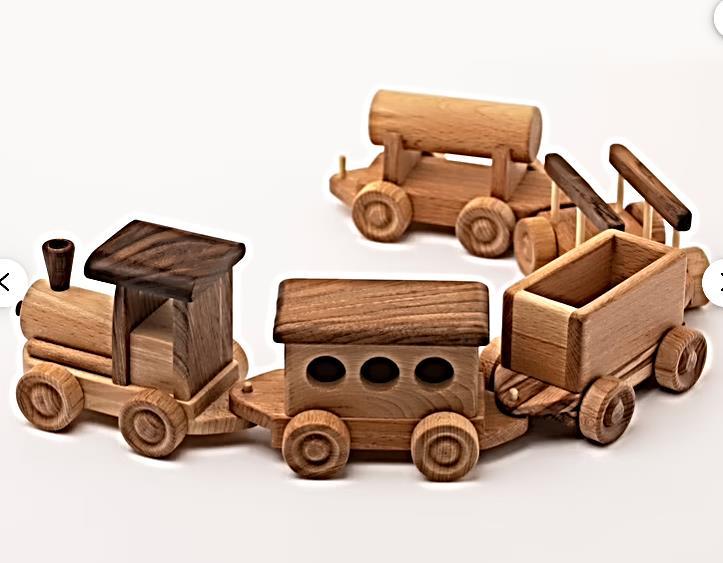
The company (STC) took Mr Tetley to court, thus commencing the case of PNG's Great Railway Robbery. Mr Tetley eventually won the case as there was no caretaker at the site and the rails were not on land belonging to the company, and therefore, they could be considered abandoned.
He is reported to have arrived at the Kerema Hall for the annual Christmas party pulling a toy train, much to the delight of those present. STC lost out badly, not only losing the rails and the money paid for them but also having to pay court costs.
89
71 Pearson M, McKillop B “End of the Line” A history of railways in Paua New Guinea UPNG Press 1997
In the period from European contact and settlement in the late nineteenth century to the end of World War 11, the timber industry was concerned mainly with speculative exploitation and reconnaissance. The utilization of the forests was mostly incidental to other activities like gold mining. Only ten sawmills were operating supplying local mission or company needs, with any surplus being sold for use in the small public and private building programmes. The only other trade was speculative exploitation of selected species as sandalwood (Santalum macgregorii) from around Port Moresby and New Guinea Walnut (Dracontomelum mangiferum) from New Britain and New Ireland.
In New Guinea, there was a sudden interest in log export in 1937, which caused the Administration to revise its legislation and consider the establishment of a forest service. In that territory, there was a mill at Waterfall Bay and mission mills also at Finschhafen, Alexishafen and Marienberg. Mills had also started at Bulolo and Wau, having been flown in from the coast. Sawn and milled timber, however, was still being imported from Australia and the Philippines to Rabaul when McAdam arrived in New Guinea in 1938 to initiate the new Forest Service. From its inception shortly afterwards until 1942, the one mill established in Rabaul led a precarious existence. However, under the stimulus of a depressed copra market and an active interest by American buyers in New Guinea walnut, many planters in New Britain and New Ireland commenced harvesting logs. In 1940/41, exports in logs and flitches of this species reached about seven and a half million super feet.
There were various attempts to establish sawmilling operations in Papua. The most tenacious of these was the Port Romilly venture and that, with Kwato Mission sawmill and the Labe Labe sawmill, which was established mainly to produce cases for shipping desiccated coconut from Milne Bay, formed the whole of the milling operations when the Japanese entered the War in 1942. Those three mills, later controlled by ANGAU, but manned with their peacetime personnel, produced a very credible supply of timber during the early days of the struggle.
During the War, the Allied Armed forces, especially ANGAU established their own sawmilling companies. By the end of the war, approximately 190,000 cubic metres of sawn timber had been produced. With the cessation of hostilities in 1945, except for Port Moresby all the cities were in ruins. This devastation coupled with a revised policy of economic activity, created an immediate demand for sawn and seasoned timber. The demand for timber in Australia and the scarcity of shipping space, made it necessary for the bulk of timber for reconstruction to be produced locally. The Provisional Administration established, and operated government run sawmills in Lae and Rabaul.

90
1952 TPNG Wood Industry Status - Jim McAdam MM 1952.
Part of his Presidential address to PNG Scientific Society72
72 PNG Scientific Society Presidential Address 1952 “Forestry in New Guinea” J B McAdam
FAO in 194873, reported that in TPNG, there were some 11 sawmills operating which in 1947 produced about 21,000 m3 (740,000 cu. ft.) of lumber. The Australian government operated a sawmill to train local sawyers and some skilled laborers. It was estimated that rehabilitation requirements will need almost 23,600 m3 (830,000 cu. ft.) a year for the next five or six years. Minor forest products include sago from the Metroxylon palm, nipa palm leaves for thatching, mangrove bark for tannin, dammar gum, canes, and bamboos.
Since the War, and owing partly to devastation by war, and partly due to the expanded services needed to cope with development of the community, there has been a greatly increased demand for sawn timber in the Territory. This has led to the gradual building up of the local sawmilling industry. In 1952, the sawn output will reach about 10 million super feet of timber requiring some 20 million super feet of logs. Since the War, there has been an embargo on the export of sawn timber, but this has been eased. For some time, we have been sending out six and a half inch square bulks of hoop and klinkii pine to provide battery separator veneer which is in critical supply in Australia. Last year, our exports of this highly selected material exceeded 400,000 super feet. Now general lines can be exported provided the millers keep a sufficient stock in their yards to ensure local supplies.
Since the War, logs have been exported annually but these exports remain constant between one and one and a half million super feet. Recently a tender has been accepted for the purchase of some 70 million super feet of timber on the Trans Busu at about 7 8 million super feet per year. It is expected that this will boost the log export considerably in about twelve months. Within the last few months, exports of private logs from agricultural leases in the Lae area has commenced because of active clearing for the establishment of cocoa crops.
FAO reported that shortly, a modern plywood manufacturing industry will be established for processing the pines of the Bulolo Valley. It is expected that within three years the output will reach 30 million square feet of plywood on a 3/16 inch basis.
McAdam reported that shortly, a modern plywood manufacturing industry would be established for processing the pines of the Bulolo Valley. It was expected that within three years the output will reach 30 million square feet of plywood on a 3/16 inch basis. Already a start has been made on reforestation with the same species. (Hoop and Klinkii). Last year, 45 acres were planted. In 1952, 100 acres were planted, and in the nursery, there is stock for 300 acres of plantation next year. It is expected that the future plantings will be about 600 to 700 acres per year. At the end of the rotation (50 years), it is calculated that the annual cut will exceed 60 million super feet of logs as against the rationed cut of 10 million super feet from the virgin stands. There will be a great volume of early thinnings from the plantations in about ten years and this may well lead to the establishment of the first pulp factory in the Territory.
74By 1952, the local sawmilling industry had reached the stage where it was able to meet the local demand and output was some 24 thousand cubic metres per annum.
In 1952 though, only 4.5 thousand cubic metres of logs and 2.4 thousand cubic metres of sawn timber were exported.
91
73 UNASYLVA Vol @ #6 Nov Dec 1948 74 UNASYLIVA
1954 ECONOMIC DEVELOPMENT PNG- Sawn Timber/Plywood Manufacture
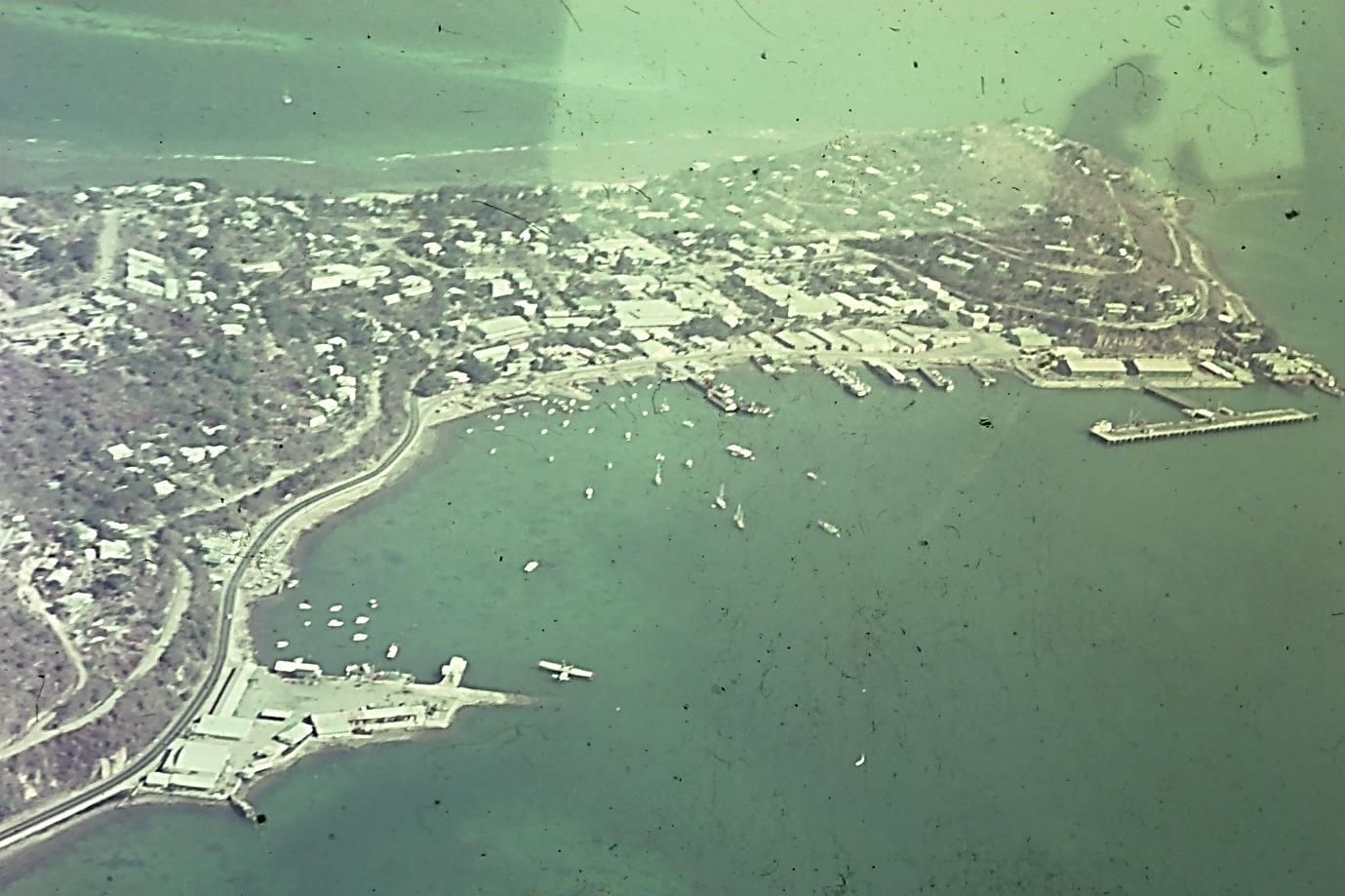
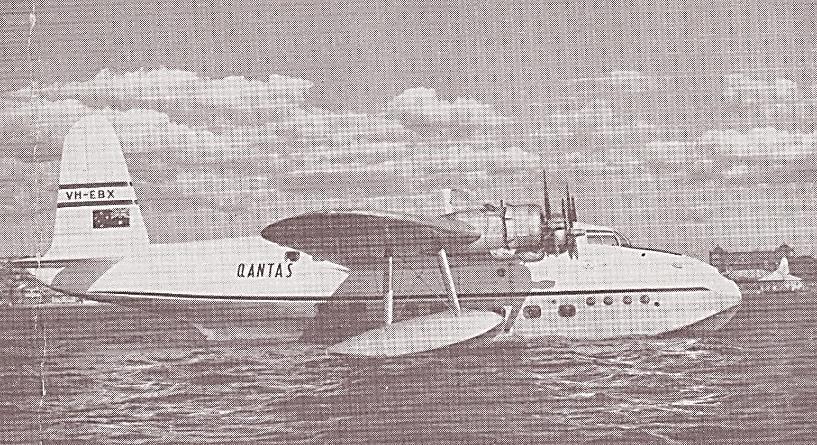
92
Qantas Sandringham flying boat that Paul Ryan flew on from Moresby to Sydney for secondary studies at Bowral in 1954. Photo credit Paul Ryan75 .
Aerial view of Port Moresby taken in 1963 with a Catalina moored in the harbor. Catalinas were withdrawn from service in PNG in 1965. Photo credit Ken Granger.
75 Ref: PNGAF Mag # 9B 5B4R1 of 26/8/21. Eminent TPNG Forester Paul Ryan p 1 50.
Commonwealth New Guinea Timbers Ltd (CNGT)
As the mining operation for gold production declined in the Wau Bulolo area, interest developed in nearby stands of Klinkii pine. Commonwealth New Guinea Timbers Ltd (CNGT) was formed by an agreement, signed in 1952 between the Commonwealth Government and Bulolo Gold Dredging Limited.
In January 1954, a plywood mill and sawmill constructed by Commonwealth New Guinea Timbers Ltd. (CNGT). (partners were the Australian Government and Bulolo Gold Dredging Company) costing some A$3 million dollars (1,300,000 Australian pounds) commenced production. It was designed to produce high grade plywood veneer about 30 million square feet annually, calculated on a 3/16th inch basis Restricted cutting of these valuable softwoods and a reforestation program ensured that the timber harvested will be replaced.
1960’s Commonwealth New Guinea Timbers Ltd (CNGT) plywood mill at Bulolo. Behind the mill to the left is a prominent Bulolo topographic feature called the Susus. In Pidgin English translated as a woman’s breasts. The large klinkii trees were not harvested because they contained too much metal shrapnel. Allied pilots on their way back from attacking Japanese positions around Lae and Salamaua used this easily identified feature for course correction, target practice and a safe place to jettison any undelivered bombs before climbing over the gap in the Owen Stanley Ranges on their return to bases in Port Moresby during WW II. Photo credit John Davidson.


93
1954 CNGT PLYWOOD MILL Bulolo. Source PNGAA
In 1954 plywood production and the export of product to overseas destinations commenced and for the past 50 years the company has been involved in the conversion of both hardwood and plantation resource to high value end products. Output rose from 2.14 million square metres on a 5 mm basis in the first year to 3.34 million square metres valued at some A$2.9 million in 1969 70.
FAO76 reported: that a major development in Australian New Guinea has been the establishment of the plywood factory at Bulolo, which commenced operations in January 1954 and it now producing substantial quantities of first cl ass plywood, the bulk of which is being exported to America and Australia.


Kinoi, a senior and skilled crosscutter, felling a klinki pine. Kinoi was a Sepik elder. Watut Bulolo ridge.

Photo credit Ross Lockyer 1969 CNGT Bush boss and forester.
Snigging a log to the Plymill.
Source. Annual Report to the UN re New Guinea 1/7/1953 to 30/6/1954.
Loading logs for the Plymill.
Source Dept of Territories 1959.
94
76 FAO Unasylva 1955 Vol 9 No 2 News of the World

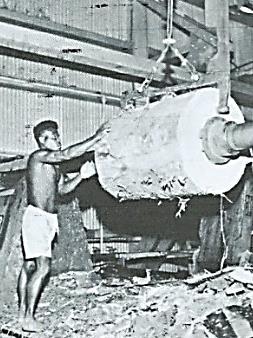


95
Log Loading Bulolo April 1965. Source University of Queensland Kathleen Vellacott Jones Collection. Transporting Logs Bulolo 1962. Photo credit PNGAA Unloading Logs Bulolo Ply Mill. Photo credit PNGAA. Peeling logs for Commonwealth New Guinea Timbers Ply Mill 1960. Photo credit PNGAA
Interior view of the Commonwealth New Guinea Timbers Limited (CNGT) Plywood Factory at Bulolo. Source Department of Territories 1959.

Transporting plywood Bulolo to the coast.
Source. Annual Report to the UN re New Guinea 1/7/1953 to 30/6/1954.
Markham Bridge

The longest bridge in the Territory, 1690 feet long spans the Markham River near Lae. Completed in 1955, it made possible the passage of heavy motor transport between Lae and the gold and timber producing area of Bulolo and Wau. Source Department of Territories 1959

96
1957 Forest Policy Statement Hasluck
Sir Paul Hasluck77 .
Minister for Territories 1951 1963

The Right Honourable Sir Paul Hasluck. Photo credit Wikipedia.
Forest Policy Statement by the Minister for Territories Hon P Hasluck MP 1957
1 Acquisition and reservation of an adequate permanent forest estate of 4 million acres (1.6 million hectares) estate within 10 years and 10 million acres in 20 years (4 million hectares )
2 Establishment of formal forestry education at a forest training school at Bulolo about 1960 for training recruits for the Auxiliary and Third Division.
3 Establishment of a forest research institute to be established at Lae in conjunction with the Herbarium.
4 A re afforestation program including expenditure in the Highlands for grassland reclamation
5 Timber utilisation research into natural durability and preservation treatments.
6 Botanical collections and identifications.
7 Encouragement of a timber industry.
97
77 Ref: PNGAF Mag # 4 of 21/11/20 p 15
1958. 78
78 REF: March, E. W. “THE SEVENTH BRITISH COMMONWEALTH FORESTRY CONFERENCE: PRE CONFERENCE TOUR OF PAPUA AND NEW GUINEA.” Empire Forestry Review, vol. 37, no. 1 (91), 1958, pp. 103 108.
98
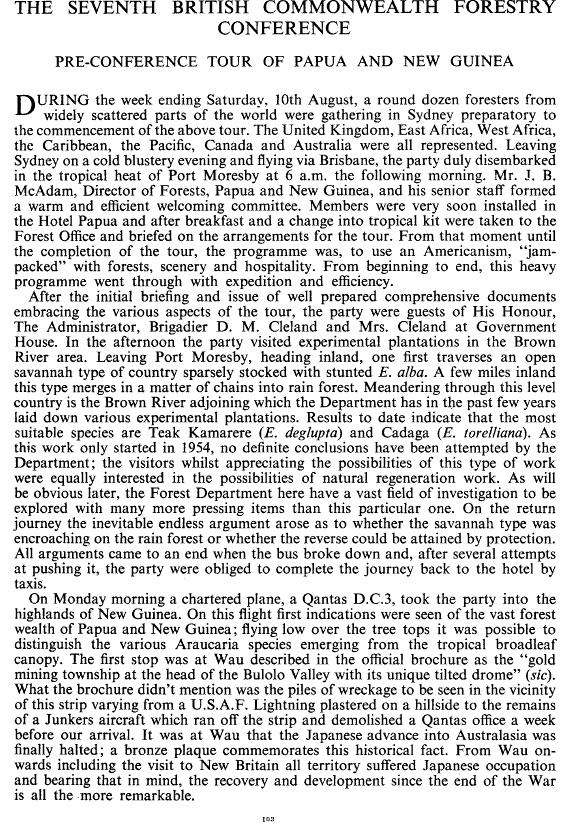

99
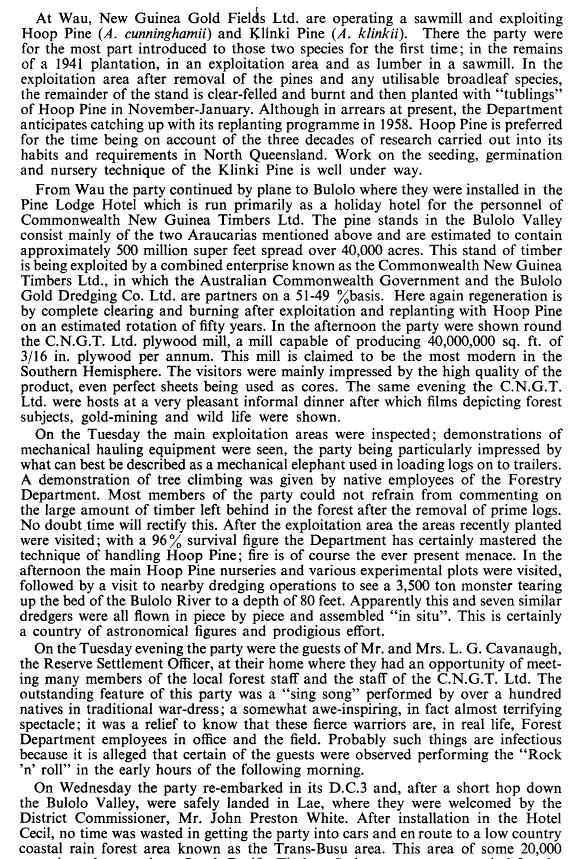
100

101
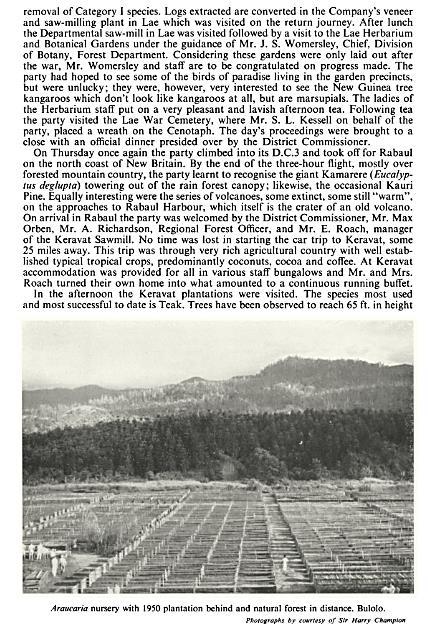
102
TPNG Department of Forests 1961 Log Measurement (Full Volume) Tables Super Feet regulation 35 (1) Forestry Ordinance

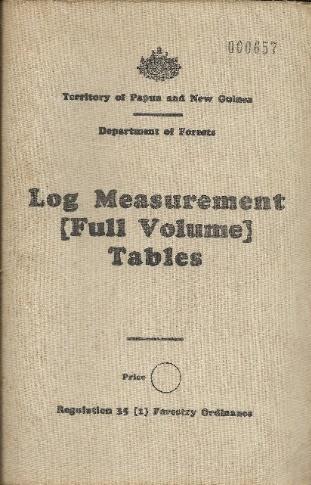
103
1960’s Foot Report
The fifth intervention came in the 1960’s with the United Nations Sir Hugh Foot Report79 of 1962 and subsequent World Bank Economic Report80 of 1965 setting out the framework for agricultural and forestry development. This included a major assessment of PNG’s Forest resources and the need for agricultural development for oil palm clearing large tracts of forested land for the planting of oil palm. The development of this agricultural pursuit also saw PNG enter the global log export trade because the large scale clearings created an enormous quantity of felled trees, which if not sold were to be burnt.
The establishment of the Bulolo Forestry College in 1962 was the commencement of formal technical training for Papua New Guineans. The first Principal was Joe Havel with Bill Finlayson, followed by Leon Clifford; then Robin Angus and later John Godlee. The College was opened by the Minister for Teritories, The Hon. C.E.Barnes MP on the 3rd of August 1965. It was then known as the Papua and New Guinea Forestry School Bulolo.

In early 1961, the Australian Government made a nationwide recruiting drive (in Australia) to interview and enlist six (6) potential Assistant Forest Rangers, as part of ten (10) students, to be the first intake for the Bulolo Forestry College. The new recruits included Bruce 79
80 Refer page 37.
104
Bulolo Forestry College Bulolo. Photo Credit Murray Day Department of Forests 1973.
Sir Hugh Foot UN Visiting Mission Report to Trusteeship Council May June 1962 and refer to page 36
Joe Havel with students studying botanical specimens at the PNG Forestry College Bulolo. Photograph 1964 Dept. of Forests



Pictured. Tony Crompton (standing) & Peter Eddowes (seated) & local field assistants. Training in forest survey work. Lower Montane Forest Bulolo 1963.
Photo credit Peter Eddowes.
Photo
105
Anderson, Tony Crompton, Rod Hall, Tony Brown, Heiner Streimann, and Peter Eddowes under the first Principal of the school TPNG forester Joe Havel.
Port Moresby.
Professor John Davidson(left) with the first forestry graduates on the day of graduation. From the left Joseph Ben, Diki Kari, Alec Chang (Fiji), Jack Noah and Oscar Mamalai. (Not in the photograph is Samson Gaviro Solomons). UNITECH 1976.
Credit Gloria Davidson. The end of 1976 saw the graduation ceremony for the first students. Two of the original students, Jack Noah and Joseph Ben are deceased81
81
Part
page
Oscar Mamalai personal communication
8 May 2019
B
365 366


106
Forestry College Bulolo L to R. Norma Collis, Blue Ramsay, Joe Havel, Bill Finlayson, Heinar Streimann. Photo credit Norma/Cheryl Collis 1964/65.
Forestry College Bulolo group photo was taken of the staff and students. L to R Norma Collis, Olga Woolcott, Heiner Streimann, Arthur Ramsay, Leon Clifford, Evan Shield, Gerry Cullen, Vivienne Shield, Pat Cattanach. Photo Credit Janelle Clifford 1966.
1968-69 DEVELOPMENT PLAN PNG FOREST INDUSTRY



The House of Assembly announcing a development program for the PNG Forest industry (1968 69 to 1972 73) which greatly impacted on the forested lands of PNG. Much of the existing Forest development in PNG today stems from that plan.
The major objectives of that plan were:
• to ensure, relative emphasis to be given to agricultural and industrial development.
• rapidly increase the production of forest products.
• increase export earnings and local employment by encouraging local processing of forest products.
• improve the supply and quality of forest products for local use, establish a fully integrated forest industry by the development of industrial complexes working within permanent forest estates.
• foster a measure of local equity participation in such industrial undertakings
• increase the levels of training and employment in the industry
• enforce environmental protection standards
• adopt a logging code of practice. (In 1996, the PNG logging code of practice was formally adopted by the PNG government).
One example of such development was the North Coast of New Britain with rainforest areas being converted to oil palm plantations.
107
Hoskins Oil Palm development New Britain 1995. Photo credit Dick McCarthy.
Bialla Dick McCarthy 1971. We did find a tree or two at Bialla. Photo Credit DOF PNG.
Mount Ulawun Volcano. Photo credit John Davidson.
1969 Status Log Export, Sawn Wood Export, Plywood and Veneer Exports
The next expansion was the log export trade. In 1952 only 4.5 thousand cubic metres of logs were exported. In 1969, some 147 thousand cubic metres of logs were exported.


108
Extraction of logs for export Vanimo TA. Photo credit Dick McCarthy 1995.
.,
Loading logs for export from Vanimo TA. Photo credit Dick McCarthy 1995.
Tropical sawn timber exports, Bay of Tokyo Japan.







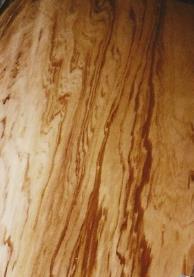
Photo credit Dick McCarthy 2003.
In 1952 2.4 thousand cubic metres of sawn timber were exported. In 1969, some 17 thousand cubic metres of sawn timber were exported.
In 1952 no plywood or veneer were manufactured for export. In 1969, some 2.48 million cubic metres of plywood (3.34 million square metres of plywood) and 12.4 million cubic metres of veneer were exported.
Veneer Western Province. Photo credit Dick McCarthy.
109
Log Pond, Bay of Tokyo Japan. Different compartments for different species and use. Plylogs being extracted for plymill by water’s edge. Photo credit Dick McCarthy 2003.
Potential of Wood Fibre - Pulp and Paper
The potential of tropical hardwoods as a source of raw material for cellulose fibre has been recognised for many years. Commercial utilisation has been low in development especially for the technical problems involved with pulping such a mixture of tropical woods given the range of diverse properties which is characteristic of the tropical hardwood forest.

Pulp and Paper The impetus to a more intensive evaluation of the pulping potential of mixed tropical hardwood species from PNG was given by the demand from the pulp and paper industry of Japan for raw material from throughout the Asia Pacific region. The technique of bulk transport of wood chips developed in conjunction with growth of this demand. The potential size of the industry was of national significance.
Case Study JANT Project Madang Gogol Woodchip Project near Madang
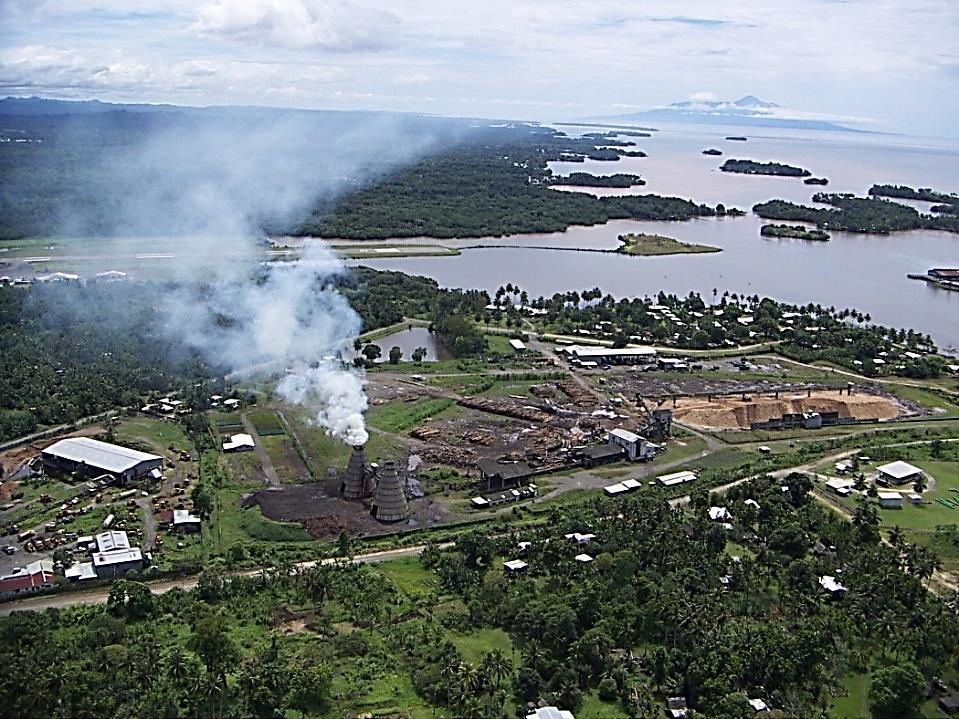
JANT Gogol TA woodchip project near Madang.
Photo credit Dick McCarthy 2000.
JANT Madang Acacia mangium plantations.
Photo credit Dick McCarthy 2000.
110
PNGAF Magazines of eminent foresters Ian Whyte, Paul Ryan describe this project in detail.
In 1969, the first trial batch of wood chips for pulp production were produced by JANT Madang.
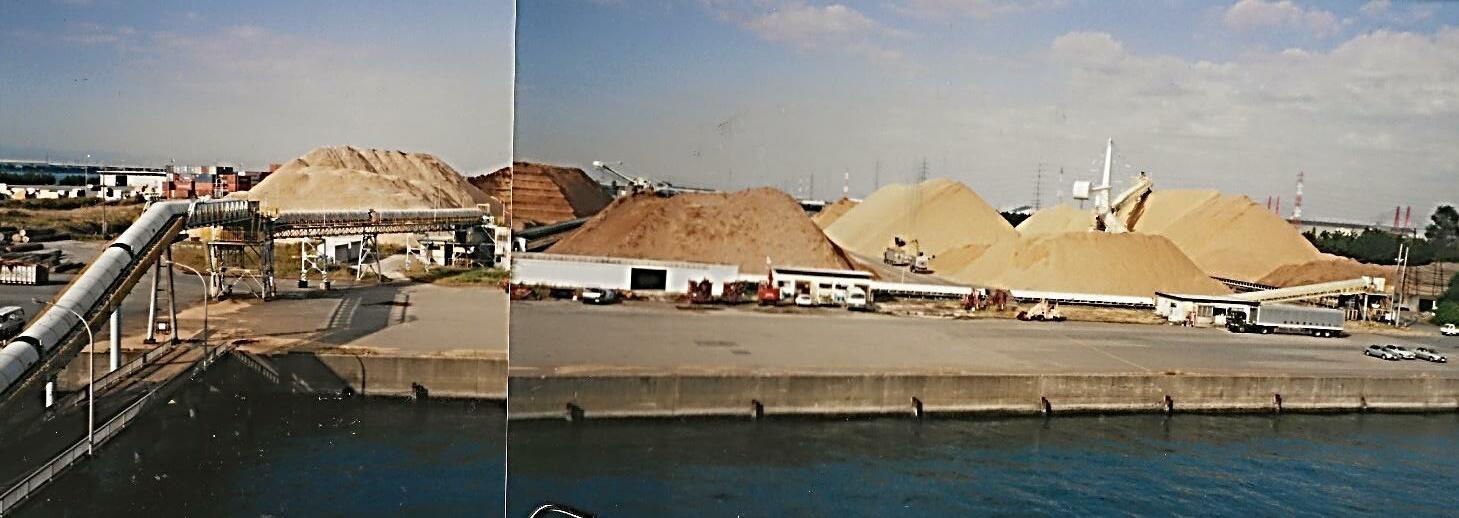
In 1975, the Japanese Pulp and Paper Industry (probably Honshu) undertook paper making Trial of plantation grown Eucalyptus deglupta. The trials used samples drawn from the range of ages in the plantations established at Kerevat and from the provenance trials established at Baku outside Madang. For Kerevat, this involved the clear felling of the 1957 58 plantation at Kerevat and shipping the logs to Japan for conversion to paper. The logs were trucked to the beach at Kabira where they were loaded onto a ship moored offshore. Des Harries82
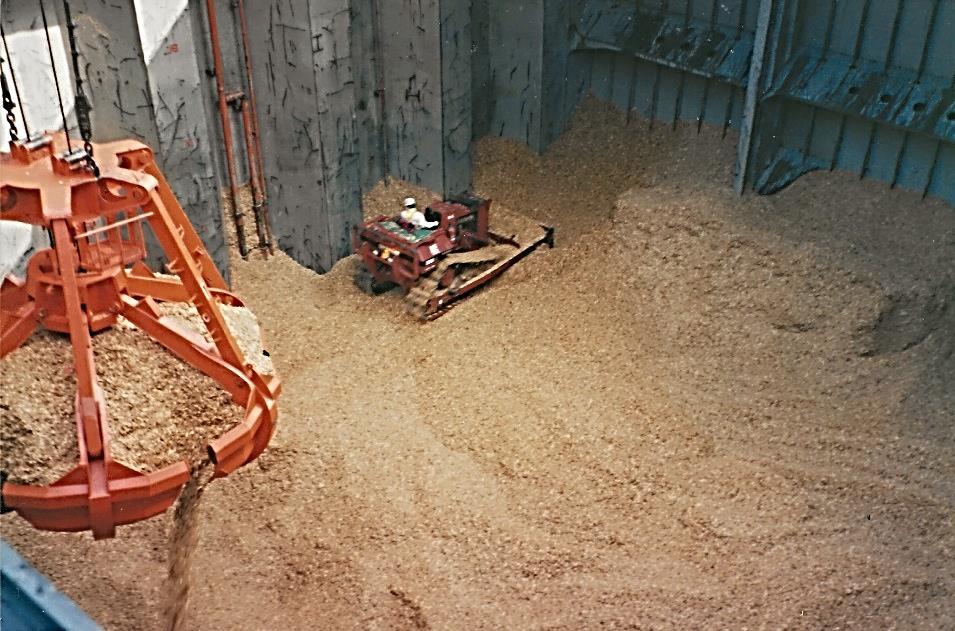
111
Bay Of Japan. Unloading woodchips from Australia. Stockpiles include tropical woodchips. Photo credit Dick McCarthy 2003.
82 Personal communication Des Harries 3Nov 2022.
Case Study - Pulp and Paper -Vanimo Timber Area Project.
The PNG Administration initiated a project designed to evaluate the pulping and papermaking potential of mixed tropical hardwoods in the Vanimo Timber area in detail in 1970 The intended outcome of this work is that it would then identify other timber resource areas in PNG as a source of wood chips.


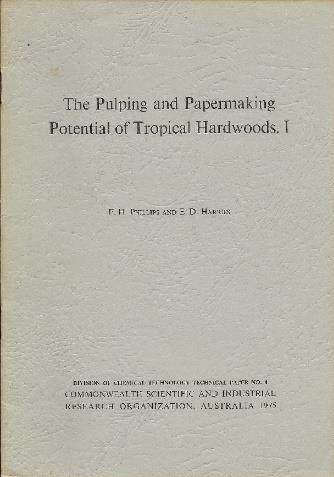

To determine the quality and potential market quality of the PNG forests for pulping potential, the Department of Forests through its Forest Products Research Centre Hohola engaged CSIRO Forest Products Laboratory83 to undertake that work. The CSIRO investigation84 , 85 initially selected Block 6 Vanimo Timber area (some 54,000 ha). Block 286 Vanimo Timber area (some 60,000 ha) was included in the investigations.
PNGAF magazine 9B 5A of 8/6/202 page 49 55 describes this project in detail.
Vanimo Survey 1970. Photo credit Ian Whyte.
Dick McCarthy with (Big Ev) Evan Shield at scales at Ossima airstrip optimising CSIRO pulpwood samples for loads for the Cessna trips. Photo credit Ian Whyte.
83
CSIRO Division of Chemical Technology Technical Paper # 1 1975 “The Pulping and Papermaking Potential of Tropical Hardwoods 1 Phillips F H and Harries E D TPNG Forests 1955 1976.
84

CSIRO Division of Chemical Technology Technical Paper # 2 1975 “The Pulping and Papermaking Potential of Tropical Hardwoods 1 Phillips F. H., Logan A.F. and Balodis V.
85
CSIRO Division of Chemical Technology Technical Paper # 2 1975 “The Pulping and Papermaking Potential of Tropical Hardwoods 1111, 1975 Logan A.F. and Phillips F H
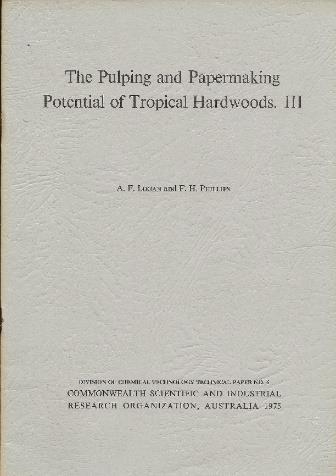
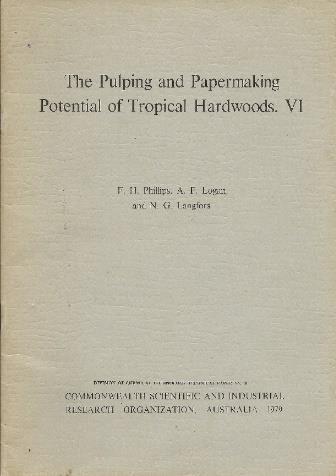
86
CSIRO Division of Chemical Technology Technical Paper #34 1975 “The Pulping and Papermaking Potential of Tropical Hardwoods 1 Logan A.F., and Phillips F H.
112
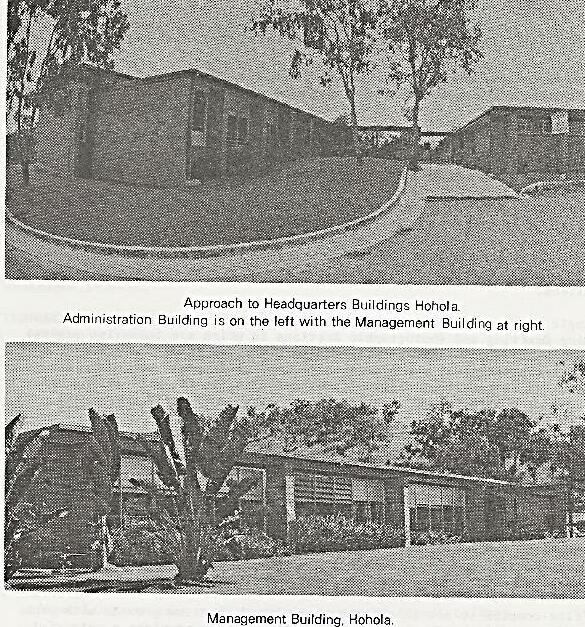
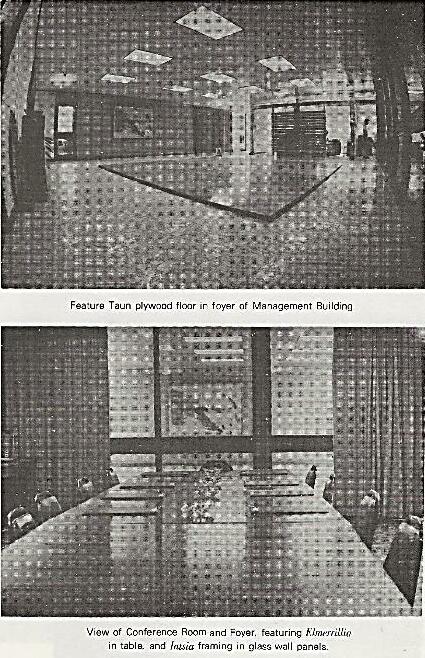
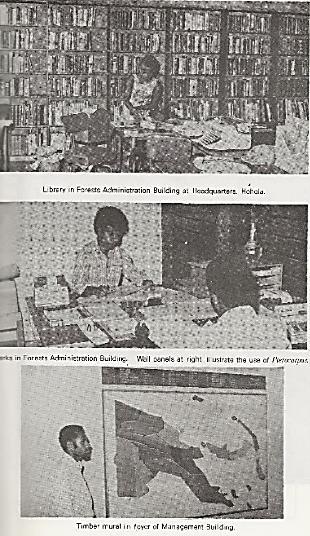
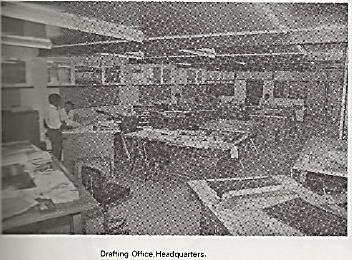

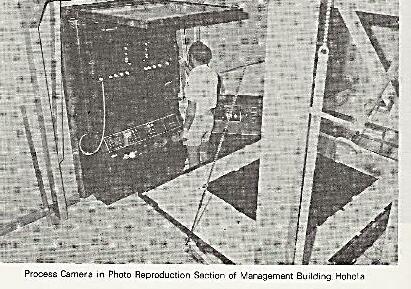
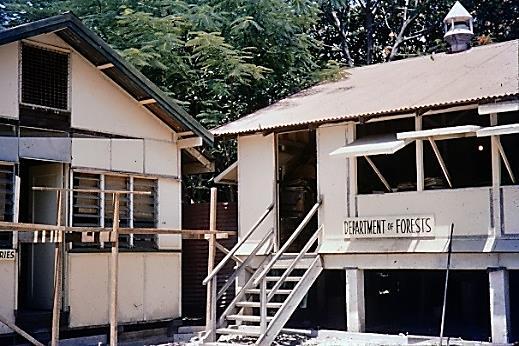
113
UNDER THEIR WATCH, WHAT WAS ACHIEVED? AN ATTEMPT AT FOREST ADMINISTRATION.
Photo Credit Cliff Southwell Headquarters of Department of Forests Konedobu till 1970
Ref:
Report
197187 New Forest Headquarters Hohola Port Moresby.
87
1971 TPNG Dept of Forests Annual
1938-1959
“JB”
James Bannister McAdam MM 1910-1959 First Managing Director of TPNG forests.
Jim McAdam was a graduate of University of Queensland and Australian Forestry School. (dux in 1932/33). In 1934, he joined Queensland Forestry. In 1938 he joined the TPNG administration and made Chief Forester 1939.

With the threat of war in the Pacific, McAdam enlisted in the NGVR. After the Japanese invaded Salamaua in March, he led a party of scouts which established an observation post within a mile (1.6 km) of enemy positions. McAdam acted as a guide in the foray and was awarded the Military Medal for his outstanding service at Salamaua.
From 1944/45 he was Lt Col 1 Aust CRE (New Guinea Forests). In 1946 he became Director of Forests TPNG. He died in 1959.
Jim McAdam’s forest management achievements as Director of the Department of Forests PNG reflect a rational economic approach to forest politics. His post war activities were associated with providing timber for reconstruction of war damage and laying foundations for future forestry development The demands and devastation caused by the war, the expanded services needed to cater for the immediate development of the community, plus an increased demand in Australia for woods, made visible for the first time a live picture of forest development.
McAdam took PNG as information of the forest resources accumulated, from a scene of early exploiters of PNG’s forest resources for sandalwood, with a small sawmill industry supplying local needs and a small export trade of walnut logs to a sophisticated export industry of plywood, sawn timber, and logs to global markets, especially Australasia. It took World War 11 to provide an impetus to expand the scope of the forest from its traditional role.
McAdam undertook ongoing initiatives to ensure forest resources for future development capitalising on the results of the Army Forest Resource Survey group he commanded. At the same time, he continued to ensure traditional owners’ rights were enshrined in forest legislation.
McAdam’s foresight saw development of initiatives for reforestation and afforestation to ensure long term forest resources availability for the country of PNG.
At the same time, he established training initiatives for ongoing professional forester development with the establishment of the TPNG Australian Forester cadetship scheme. His objective was that this be the forerunner to the training of PNG foresters.
114
1959-1970
After graduating from the Australian Forestry School, in 1932 Bill Suttie joined the Queensland Department of Forestry. He was a founding member of the Institute of Foresters of Australia in 1935.
During the second world war, he was in command of 1 Australian Forestry Survey Coy in Papua New Guinea, under 1 Command Royal Engineers (New Guinea Forests) as the Headquarters Unit, with J B McAdam (head of pre war New Guinea Forest Service) as commanding officer

After the war, he held several positions with the Department of Forestry in Queensland, the last being District Forester Atherton in North Queensland until he resigned in 1956 to join the Department of Forests in the Territory of Papua New Guinea.PNG. Here, he rose to be the second Director of Forests in PNG. After retiring from TPNG he lived at Caloundra until his death in 1982.
Bill Suttie’s forest management achievements as Director of the Department of Forests PNG are outlined in his Presidential address to PNG Scientific Society 1962 89. He linked political directives of Spender in 1951 and Hasluck in 1957 with development of the functions of the Department of Forests in resource investigation, forestry education, biological and utilisation research, reforestation, afforestation, and acquisition of a permanent forest estate.
Suttie noted that this marked a change from a period of exploitation to one of a consciousness of the need for a long term forest conservation policy primarily in the interests of the native inhabitants of the Territory and the future need to train them in an awareness of the value of its forest resources.
Suttie outlined the extent of forests required for permanent or sustained supply of wood products and proposed measures in acquiring such a forest estate.
115
Bill Suttie Managing Director PNG Forest Service 1959 197088 .
88 Photo credit Linda Cavanaugh Manning. (background is Dave Dun 1957 Bulolo).
89 PNG Scientific Society Presidential Address 1962 “A Transition Period” W R Suttie
Don McIntosh TPNG Forests 1946-1973. Third Managing Director TPNG Forests 1970 1973.


Don’s military service was in the Royal Australian Navy Service Number S10526, home port Sydney NSW with the rank of Able Seaman. He enlisted on 31 May 1945 and was discharged on 6 January 1947 (most fitting defence service for sailing the political seas of forestry later in his career). Don McIntosh 1927 2015 joined Forests PNG in 1948 as a cadet forester. After completing his studies at the Australian Forestry School Canberra 1950 51, under the TPNG Forestry cadetship scheme where his classmates included Ted Gray and Kevin White, Don returned to PNG in 1952 He held positions included Regional Forest Officer Lae, Chief of Forest Management before becoming the third Director of Forests in the Dept of Forests PNG.
Kevin White Assistant Director till 1977
Kevin White at Brown River Teak Plantations 1970 with Evo Vai. Photo credit Dept of Forests TPNG

Kevin 1924 2012 joined TPNG forests in 1957. He completed the first stage of secondary education in 1941 and then worked for a spell in the Queensland Public Service in Brisbane, enlisting in the AIF in 1942 (QX57633/Q144919) He shipped out to New Guinea where he was taken on by 39 Light Wireless Air Warning Section as an electrician and later returned to Australia for radio technician training Back in New Guinea he was attached to the 2nd Australian Corps Signals at the transmitter centre on the Sattelburg trail above Finschhafen, and later at Torokina on Bougainville. There at Torokina Kevin celebrated his 21st birthday and the end of the Pacific war.
After his discharge (26 Sep 1946), he re joined the Queensland Public Service but opted for retraining under the Commonwealth Reconstruction Training Scheme He firstly completed his secondary schooling and then became a Cadet Forest Officer of the Queensland Department of Forestry graduating at AFS in 1952. The next five years were largely spent on rainforest management research in North Queensland Kevin transferred to the Forest Department of the Territory of Papua & New Guinea in 1957 as Assistant Botanist and Plant Ecologist at the Botany Division of the Department in Lae rising to Assistant Director Dept of Forests PNG. After PNG he undertook various consultancies including FAO Bangladesh and ADB Nepal.
90 Ref: PNGAF Mag # 4 of 21/11/20 p36. Ref: PNGAF Mag # 3 of 3/11/20 p 40. Ref: PNGAF Mag # 9B 5B4M2 of 27/7/21. Eminent TPNG Forester Don McIntosh p1 24.
116 1970-197590
Under McIntosh and White’s Guidance Forest Management Achievements by1975 were:
Forest Resources. In the period 1946 1963 some 600,000 hectares were assessed by conventional methods. From 1964 to 1967 some 2.8 million hectares were assessed. As of 1975, a total of 5.2 million hectares had been assessed. The investigations confirmed that there was a resource of magnitude, it quantified the resource, and identified the areas considered suitable for development.
Botany
• Collection and maintenance of specimens of Papuasia plants. From the collections commenced in 1944, the herbarium collection at 1975 has over 250,000 PNG specimens. From the collections, followed taxonomic studies of the flora leading to various publications and training manuals.
• Development at Lae of the National Botanical Gardens with living collections.
• Intensive service in identification of plant specimens.
• Communication; extension services.
• National staff training.
Forest Industry
• From two sawmills in 1946 to 1975 with some 90 sawmills, one plywood plant; three veneer plants and one wood chip mill.
• An annual log harvest of some 800,000 m3 as of 1975.
• By 1975, export earnings of some Kina 15 million.
• Establishment of a Papua New Guinea Timber Marketing Advisory Panel.
• Development of an appropriate wood utilisation research program:
(a) Determination of the properties and uses of PNG timbers.
(b) Development of appropriate timber preservation treatments for sawn and round timbers.
(c) Determination of kiln drying schedules.
(d) Development of minor forest product industries.
(e) Provision of mill wright services and extensive industry advice services.
(f) Timber design services.
(g) Technical publication services especially for building designs using local materials.
(h) Training of mill operators.
Forest Management
• Development and administration of complex forest management agreements including regeneration treatment.
Reforestation
• Over 16,000 hectares plantations established at Bulolo/Wau, Kerevat, Port Moresby, Goroka, and Whagi Valley.
117
• Nursery and field techniques established for species as teak (Tectona grandis); Kamarere (Eucalyptus deglupta), hoop and klinkii pine (Araucaria cunninghamii and A. hunsteinii), Eucalyptus and Pinus spp.
• Country wide extension programs, especially in the Highlands.
• Natural regeneration techniques for cut over forests, growth studies, enrichment planting techniques.
• Intensive research programs for plantation species covering species selection, tree breeding, nutrition studies, protection from insects and fungal pathogens, growth studies, range management; extension practices, environmental planning
Training
• Sub professional training program commenced in 1962 at Bulolo Forestry College which by 1975 had successfully trained some 421 trainees. In 1975, BFC could accommodate some 170 students.
1. Inservice for expatriate field officers.
2. Two year technical certificate with entry level of form 2 3.
3. Short vocational courses for supervisory staff training.
4. 1967 three year course leading to a Diploma in Forestry.
5. 1973 75 selected field staff 12 month course for a Certificate in Forestry.
6. 1969 three year Diploma of Cartography course.
•
Professional Training Program
1. Course activated in 1971/72 for a Forestry Degree course, commenced with 2 years science and two years at UNITECH Lae.
2. Four graduates expected in 1976 and 10 in 1977.
•
Industrial training
1. Closure of government sawmills had a detrimental impact on training of industrial staff.
2. Negotiations in more recent years lead to the establishment of an industry training centre in Lae (TITC).
118
REFERENCES
Burnett G 1908 Timber Trees of the Territory of Papua. Reports and Catalogues Dept. of External Affairs J Kempe Melbourne Australia.
Commonwealth New Guinea Expedition 1922 Interim Report: Reporting on the Natural resources of the Mandated Territory, Sydney.
Dargavel J 2006 From Exploitation to Science: Lane Poole’s forest surveys of Papua and New Guinea 1922 24 Historical Records of Australian Science. 17, 71 90.
Dept. of Forests Forest Products Research Centre 1970 Properties and Uses of Papua and New Guinea Timbers Revision 1970, Port Moresby
Eddowes P 1977 Commercial Timbers of Papua New Guinea Their Properties and Uses First published in 1961 Forest Products Research Centre Papua New Guinea.
Jacaranda Press 1973 NEW HORIZONS Forestry in Papua New Guinea Brisbane Lane Poole C E 1925 Forest Resources of the Territories of Papua and New Guinea
Lewis DC 1996. The PLANTATION DREAM Developing British New Guinea and Papua 1884 1942
McAdam J 1952 Forestry in New Guinea Address to Papua and New Guinea Scientific Society Annual Report.
Phillips EH (1), Harries ED (2) CSIRO FPRC PNG 1975 The Pulping and Papermaking Potential of Tropical Hardwoods I. Requirements for an effective evaluation of the forest resources in Papua New Guinea.
Phillips EH, Logan AF), Balodis V. 1975 The Pulping and Papermaking Potential of Tropical Hardwoods II. Division of Chemical Technology CSIRO Australia.
Phillips FH, Logan AF, Balodis V 1975 CSIRO Division of Chemical Technology
The Pulping and Papermaking Potential of Tropical Hardwoods Properties of Pulps from Wood Chip Mixtures Representing Block 6 Vanimo Timber Area New Guinea Technical Paper # 5.
Phillips FH, Logan AF 1975 CSIRO Division of Chemical Technology
The Pulping and Papermaking Potential of Tropical Hardwoods Properties of Pulps from Wood Chip Mixtures Representing Block 2 Vanimo Timber Area New Guinea Technical Paper # 6.
Phillips FH, Logan AF, Langfors NG 1979 CSIRO Division of Chemical Technology
The Pulping and Papermaking Potential of Tropical Hardwoods Mixed Species from the Gogol Timber Area Papua New Guinea Technical Paper # 10.
Ryan P 1972 Editor Encyclopedia of Papua and New Guinea
World Bank 1965 Report # 11153 The Economic Development of Papua and New Guinea.
119
ACRONYMS
AAD Australian Antarctic Division
ACT Australian Capital Territory
ACIAR Australian Centre for International Agricultural Research
ACLMP AusAid funded World Bank Land Mobilisation program.
ACP African, Caribbean and Pacific States
ADB Asian Development Bank
ADD Air Dry Density
AEC Administrators Executive Committee
AFAP Australian Foundation for the Peoples of Asia & the Pacific Ltd.
ADB African Development Bank
AFLEGT African Forest Law Enforcement, Governance and Trade
AFPNG Association of Foresters of PNG
AFS Australian Forestry School
AFTA Asean Free Trade Area
AIF Australian Infantry Forces
AMF Australian Military Forces
ANBG Australian National Botanical Gardens
ANGAU Australian New Guinea Administrative Unit
ANU Australian National University
APEC Asia Pacific Economic Cooperation
APMF Australian Paper Manufacturers Forestry Pty Ltd
APPM Australia Paper and Pulp Manufacturers
ARD Afforestation, Reforestation and avoided Deforestation
ASEAN Association of South East Asian Nations
ASIO Australian Security Intelligence Organisation
ASOPA Australian School of Pacific Administration
ATIBT Association Technique Internationale des Bois Tropicaux
ATL Accelerated Tariff Liberalization
ATO African Timber Organization
AusAID Australian Aid Agency
BA basal area
BCOF British Commonwealth Occupational Force 1945 52
BDV Brussels Definition of Value
“Beer Time” Any time.
BFC Bulolo Forestry College
BGD Bulolo Gold Dredging Company
BNGD British New Guinea Development (Company Limited)
BUC Bulolo University College
C Commonwealth
cm centimetre
CALM Western Australian Department of Conservation and Land Management
CBD Convention on Biological Diversity
CDM Clean Development Mechanism
CEFACT United Nations Centre for Trade Facilitation and Electronic Business
CEPT Common Effective Preferential Tariff
CERFLOR Certificate of Origin of Forest Raw Material, Brazil
CFA Commonwealth Forestry Association
120
CFE Community forestry enterprise
CGTM Cintra for Global Trade Model
CIF cost, insurance, freight
CIFOR Centre for International Forestry Research
CITES Convention on International Trade in Endangered Species of Wild Fauna and Flora
C & I Criteria and indicators
CNGT Commonwealth New Guinea Timbers Bulolo
CO2 carbon dioxide
COC chain of custody
COP Conference of Parties
CPF Collaborative Partnership on Forests
CRE Commander Royal Engineers
CRE CRE is a term inherited by RAE from RE and is the term for the Commanding Officer of a RAE unit which is headed by a Lt Col. Although the officer is called the CRE the name is also used for the name of his unit.
E.g., CRE Aust Forestry Group or 1(NG Forests).
CSIRO Commonwealth Scientific & Industrial Research Organisation
CHAH Council of Heads of Australasian Herbaria
C&I Criteria and Indicators
C&L Certification and Labelling
CSD Commission on Sustainable Development (United Nations)
CTE Committee on Trade and Environment
DASF Dept of Agriculture, Stock and Fisheries
DBH/ dbh Diameter at breast height
DEPT Department
DESA United Nations Department of Economic and Social Affairs
DIES Department of Information and Extension Services
DIY Do it yourself
DPI Department of Primary Industry
DOF Department of Forests
DSB Dispute Settlement Body
EC European Commission ECA Export credit agency
ECE Economic Commission for Europe
ECOSOC Economic and Social Council of the United Nations
EEA European Economic Area
EFI European Forest Institute
EIA Environmental Investigation Agency
EMAS Eco Management and Audit Scheme of European Union
EMS Environmental Management System
ENB East New Britain Province.
e.g. For example
ENGO Environmental Non governmental Organisation
Etc et cetera (more of the same)
EU European Union
EVSL Early Voluntary Liberalisation
FAO Food and Agriculture Organisation
F &TB Forest and Timber Bureau Canberra
FIM Forest Information System
121
FMA Forest Management Agreement
FPRC Forest Products Research Centre Hohola
FRA Forest Resource Assessment
FRG Forest Red Gum
FRI Forest Research Institute Lae
Forkol Bulolo Forestry College
FSP/PNG Foundation of the Peoples of the South Pacific
FCCC See UNFCCC
FD Forest department
FDI Foreign direct investment
FIELD The Foundation for International Environmental Law and Development
FLEGT Forest Law Enforcement, Governance and Trade
FLEG Forest Law Enforcement and Governance
FLONAS National Forest logging concessions, Brazil
FOB free on board
FPRC Forest Products Research centre Hohola Dept of Forests PNG
FSC Forest Stewardship Council
FTAA Free Trade Area of the Americas
GAB Girth above buttress
Gbhob Girth breast height over bark
Gubab Girth under bark above buttress
GIS Geographic Information Systems
G8 Group of Eight (leading economies)
GATT General Agreement on Tariffs and Trade
GDP Gross Domestic Product
GEF Global Environment Facility
GFTN Global Forest and Trade Network
GFPM Global Forest Products Model
GHG greenhouse gas
GIS Geographical information system
GMO genetically modified organism
GNP Gross National Product
GPA Plurilateral Government Procurement Agreement
GSP Generalized System of Preferences
GTZ Deutsche Gesellschaft für Technische Zusammenarbeit ha hectare
IBRD International Bank for Reconstruction and Development
IEA International Energy Agency
IFA Institute of Foresters of Australia
IFY International Year of the Forest
IADB Inter American Development Bank
IBAMA Amazon Environmental Institute, Brazil
ICA International Commodity Agreement
ICCI International Conference on C&I for Sustainable Forest Management
IDB Inter American Development Bank
IEA International Environmental Agreement
IEC International Electrical Commission
IFC International Finance Corporation
IFF Intergovernmental Forum on Forests
122
IHPA International Hardwood Products Association
IIED International Institute for Environment and Development
IMF International Monetary Fund
INGO International Non Governmental Organisations
IPC Integrated Programme for Commodities
IPCC Intergovernmental Panel on Climate Change
IPF Intergovernmental Panel on Forests
ISO International Organization for Standardisation
ITC International Trade Centre
ITTA International Tropical Timber Agreement
ITTC International Tropical Timber Council
ITTO International Tropical Timber Organization
IUCN The World Conservation Union
IWPA International Wood Products Association
JICA Japanese International Cooperation Agency
L of N League of Nations
LRRS Land Resource Soils Survey (branch of CSIRO)
LCA Life Cycle Analysis
LEEC London Economic and Environmental Centre
LEI Indonesian Ecolabelling Institute
LULUCF Land Use, Land Use Change and Forests
m3 cubic metre
MCCAF McCarthy & Associates (Forestry) Pty. Ltd.
MHA Member of House of Assembly PNG
MM Military Medal
MUS Malayan Uniform System
MEA Multilateral Environmental Agreement
MFN Most Favoured Nation
MIGA Multilateral Investment Guarantee Agency
MOU Memorandum of Understanding
MTTC Malaysian Timber Certification Council n.a. not available
NAA National Archives Australia
NARI National Agriculture Research Institute
NB New Britain
NAFTA North American Free Trade Agreement
NGO Non Governmental Organisation
NHLA National Hardwood Lumber Association
NRRP Natural Resources and Rights Program
NT National Treatment
NTB non tariff barrier
NTCC National Timber Certification Council
NTFP non timber forest product
NTM non tariff measures
NWFP non wood forest product
NDS Northern District Sawmills
NFCAP PNG National Forestry and Conservation Action Plan
NGM New Guinea Mainland no. number
NG New Guinea
123
NGF New Guinea Forces (relates to plant collection of Lae Herbarium)
NGIB New Guinea Infantry Battalion
NGI New Guinea Islands
NGO Non Government Organisation
NGVR New Guinea Volunteer Rifles
NZ New Zealand
NSW New South Wales
NTSC National Tree Seed Centre PNG Bulolo
OECD Organization for Economic Co operation and Development
OTO Office of Trade and Investment Ombudsman
OIC Officer in Charge
OISCA Organisation for Industrial, Spiritual and Cultural Advancement International Japan.
OTML Ok Tedi Mining Ltd
P or p page
PEFC Pan European Forest Certification Scheme
PIB Papuan Infantry Battalion
PIR Pacific Islands Regiment
PNG Papua New Guinea
PNGAA Papua New Guinea Australia Association
PNGAF Papua New Guinea Australian Foresters Magazine Series
PNGFA Papua New Guinea Forest Authority
PNGFIA PNG Forest Industries Association
PNGRIS Papua New Guinea Resource Information System
PNGUT PNG University of Technology
POM Port Moresby
P&C Principles and Criteria
PEFC Pan European Forest Certification Framework
PGA Plurilateral Agreement on Government Procurement
PPM production and processing method
PPP Polluter Pays Principle (other meaning Purchasing Power Parity)
QLD Queensland
QF Queensland Forestry
RAE Royal Australian Engineers/Australian Army
RPC Royal Papuan Constabulary
RRA Rapid Resource Appraisal
RIIA Royal Institute of International Affairs
RIL reduced impact logging
RFE Russia Far East
RTA Regional Trade Agreement
RWE roundwood equivalent
SAP structural adjustment programme
SPS Sanitary and Phytosanitary Measures
SFM Sustainable Forest Management
SGS Société General de Surveillance
SMS Selective Management System Malaysia
SP South Pacific
SPWP Secondary Processed Wood Products sq m square metres
TAG Trade Advisory Group of ITTO
124
TSS Tropical Shelterwood System
TBT Technical Barriers to Trade
TFF Tropical Forest Foundation
TFRK traditional forest related knowledge
TNC Transnational corporation
TRADC Timber Research & Development Advisory Council Qld.
TRAINS Trade Basic Indicators of UNCTAD
TREM trade related environmental measures
TRIM Trade Related Investment Measures
TRIP Trade Related Aspects of Intellectual Property Rights
UK United Kingdom
UN United Nations
Unasylva Journal of FAO of UN
UNCCD United Nations Programme to Combat Desertification
UNCED United Nations Conference on Environment and Development
UNCSD United Nations Committee on Sustainable Development
UNCTAD United Nations Conference on Trade and Development
UNESCO United Nations Economic and Social Council
UNDP United Nations Development Programme
UNECE United Nations Economic Commission for Europe
UNEP United Nations Environment Programme
UNFCCC Framework Convention on Climate Change of United Nations
UNFF United Nations Forum on Forests US,
USTR Office of the US Trade Representative
UNE University of New England Armidale NSW
UNEP United Nations Environment Program
UNI University
UNITECH University of Technology Lae PNG
UNRE University of Natural Resources and Environment
UPNG University of Papua New Guinea
UQ University of Queensland
US United States
USA United States of America
USD United States dollar
TPNG Territory of Papua and New Guinea
TUBL Territory United Brewery Ltd
TA Timber Area
TA Timber Authority
TRP Timber Rights Purchase
Vol volume
VSF Victorian School of Forestry
WA Western Australia
WB World Bank
WCMC World Conservation Monitoring Centre
WCO World Customs Organisation
WSSD World Summit for Sustainable Development
WTO World Trade Organization
WWF World Wide Fund for Nature
125
126

































































































































































































































